








By Ebony JJ Curry SENIOR REPORTER
By Ebony JJ Curry SENIOR REPORTER
Michigan lawmakers are pushing forward with a bill that would allow law enforcement to use roadside saliva tests to determine whether drivers are under the influence of drugs, including marijuana. That proposal has reignited concerns about racial profiling, scientific reliability, and whether these tests would create more harm than safety, especially for Black drivers already navigating a deeply flawed legal system.
Late Thursday night, Sept. 14, a historic moment unfolded in American labor relations as the United Auto Workers (UAW) union initiated a strike against Ford, General Motors (GM), and Stellantis. For the first time, the union took simultaneous action against all three major Detroit-based automakers. The action involves approximately 13,000 UAW members in assembly plants across Michigan, Ohio, and Mis-
The legislation, introduced by Rep. Brian BeGole, a Republican from Perry, would make Michigan the 25th state to allow officers to administer roadside oral fluid tests to screen for substances like marijuana, amphetamines, opioids, cocaine, and heroin. According to BeGole, “It’s just a tool to let them know if (the officer) had some reasonable suspicion … that they’re under the influence of a narcotic.”

n a breathtaking celebration of talent, determination, and the unyielding spirit of Black excellence, the Michigan Chronicle marked its 10th Annual 40 Under 40 event Thursday evening. This year’s soirée, drenched in the theme “All Black Everything with Gold Accents,” transcended expectations and essentially illuminated the golden gems within the true essence of Black excellence. Hosted by the charismatic duo of Andre Ash and Lynzee Mychael from Michigan Chronicle’s Finally Friday, the night was a triumph for the city of Detroit and its vibrant community of young Black pro-
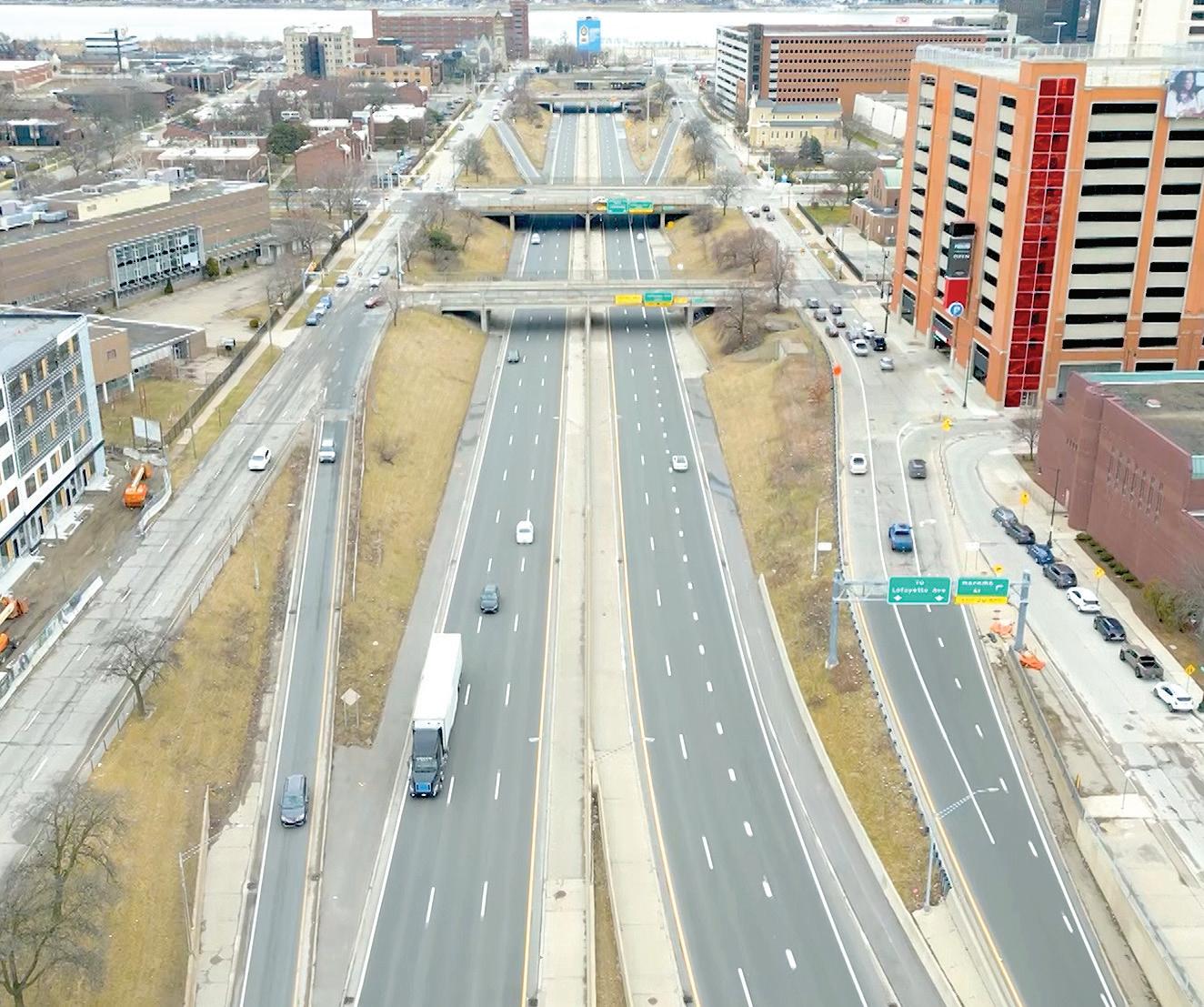
By Ebony JJ Curry SENIOR REPORTER
But for many Black communities in Michigan, where law enforcement already polices bodies with a heavier hand, adding saliva tests to the roadside stop toolkit feels less like safety and more like surveillance wrapped in a new machine.
The evening sparkled with a golden promise as we celebrated remarkable individuals from various walks of life. Among the honorees were the brilliant and visionary co-founders of Detroit Hives, Nicole Lindsey and Timothy Paul Jackson. Their work has not only changed the landscape of beekeeping and urban farming in Detroit but also exemplified the transformative impact Black professionals can have on their communities.
also expressed disappointment in a statement, saying the company immediately went into contingency mode to protect its operations.
“Entrepreneur of the year – that’s a big deal,” said Brown. “It’s always an honor to be honored and it’s always a blessing to be in a room full of so many talented, accomplished, and popular people that look like me. I’m geeked. I started making and selling clothes as a kid and I always knew that I would have a business, but I never knew it would be Detroit’s brand name business, so I take a lot of pride in the fact that our business represents our city’s pride.”
By Ebony JJ Curry SENIOR REPORTER
Taking home the Corporate Excellence Award was Dannis Mitchell, Director of Community Engagement at Barton Malow.
The tool in question is the SoToxa mobile test — a $6,000 device that uses a mouth swab and returns results within five minutes. BeGole emphasized that the test wouldn’t be the final word. “If the subject was arrested and transported to a more secure setting again, that would be where they would do the second collection of the oral fluid and then that would be placed in an evidential kit and … sent to the forensic laboratory for further examination.” Those results would come back within 24 hours and serve as the evidence prosecutors rely on.
As plans to reimagine Detroit’s infamous I-375 freeway move forward, voices on both sides of the aisle continue to speak up. On one hand, you have project leaders who are enthusiastic about the reimaging and the next steps in the development process, while on the other hand, community leaders and elected officials have voiced growing concerns, questioning whether the project truly serves those once displaced by its creation.
ness district that had been the lifeblood of the community.
“Together we have created a social, environmental, and financial impact through bees,” said Jackson. Lindsey followed that sentiment with, “It is through our local partnerships and collaborative efforts that we exist in over 28 plus locations managing the health of 4.5 million honeybees – humbly speaking our movement has inspired others locally, nationally, and even internationally to take on similar missions.”
The UAW has branded the industrial action as the “Stand-Up Strike,” focusing on specific plants within each automaker. UAW President Shawn Fain stated, “This strategy will keep the companies guessing. It will give our national negotiators maximum leverage and flexibility in bargaining. And if we need to go all out, we will. Everything is on the table.” Union leaders have also indicated that additional plants could be targeted in future waves if negotiations remain stalled.
For many Detroiters, Interstate 375, or I-375, has long been just another stretch of urban highway, a concrete artery connecting different parts of the city. To some, it’s a mere convenience; to others, it’s an unremarkable part of their daily commute. However, there’s a deeper, far more troubling story beneath the surface of this seemingly ordinary freeway—a story of pain, displacement, and the lasting impact on Black Detroiters.
Detroit Hives, a pioneering organization founded by Lindsey and Jackson, harnesses the power of urban beekeeping to revitalize neighborhoods in the Motor City. Their initiative not only addresses critical issues like environmental conservation but also provides valuable education and employment opportunities to Black De-
But questions continue to rise around whether these tools can be trusted to deliver justice or if they open yet another path to wrongful arrest and legal entanglement. A November report published by the University of Michigan’s Ford School of Public Policy raised flags. “There are no industry standards for accuracy or sensitivity in the manufacture of these tests,” it stated. The research pointed to incidents of false positives and negatives, concluding they cast doubt on the entire process.
“It is so important to recognize that there are young leaders across the country, many that are born here in Detroit. I represent our city nationally and I tell people, ‘Yea I’m a D-girl I’m from the west-side of Detroit,’” Mitchell expressed. “But more importantly, I’ve been able to have experiences within an industry that not many of us, specifically women of color, have the opportunity to engage in and I’ve been the youngest person in the room, the only Black person in the room, and the only Sistah in the room, and I really had to articulate the importance of showing up, giving chances when others won’t, and being persistent.” As a trailblazing Black woman thriving in a predominantly male-dominated industry, her unwavering commitment to fortifying the connections between businesses and Detroit’s communities is unde
While the Michigan Department of Transportation (MDOT) frames the redesign as a necessary step toward improving pedestrian safety and modern infrastructure, many Detroiters are calling for a deeper reckoning—one that addresses the generational trauma and systemic displacement rooted in the freeway’s original construction through Black Bottom and Paradise Valley.
The word “reparative” never appears in MDOT’s materials, and for many, that absence speaks louder than any rendering or artist’s vision. While MDOT is focused on building a safer and more connected transportation corridor, Detroiters are pushing for something more layered. The call is not just for smoother streets or better bike lanes. Instead, the call is for justice, remembrance, and investment that heals. Both goals — public safety and community restoration — matter. Both deserve the same urgency.
It’s a history marred by pain, injustice, and economic devastation. More than 130,000 residents, primarily Black, were forcibly displaced. Families were uprooted, generational wealth was obliterated, and a thriving community was torn asunder. The wounds inflicted by I-375 run deep, transcending the physical barrier of a freeway to penetrate the very soul of Black Detroiters.
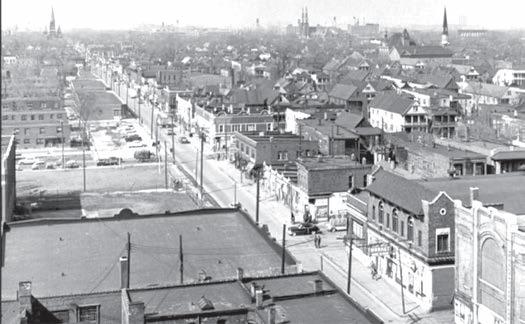
The I-375 Boulevard Project is about more than just correcting historical injustices; it’s about redefining the future. It will connect downtown Detroit to surrounding neighborhoods, bridging the gap that was placed upon the city decades ago.
of Black Bottom and Paradise Valley all those years ago — especially when you consider that many of them were only given 30 days to relocate once the decision had been made to demolish their homes.”
This painful legacy can be traced back to the nation’s interstate highway program of 1956—a program that aimed to connect the country but often did so at the expense of marginalized communities. In the case of I-375, it meant carving a path through the heart of Black Detroit, reinforcing segregation, and perpetuating inequality.
By Andre Ash DIGITAL ANCHOR
State data shows that 230 people in Michigan lost their lives in drug-impaired crashes in 2023. That figure may seem to justify stricter roadside enforcement, but when enforcement mechanisms disproportionately affect Black drivers and rest on shaky scientific ground, safety becomes a selective privilege, not a public right.
The tale begins in what is now Lafayette Park, once known as Black Bottom—a neighborhood rooted in African-American culture and history. Named after its dark, fertile soil, Black Bottom flourished during the mid1900s, nurturing the dreams and aspirations of prominent Detroiters like Coleman Young, Joe Louis, and numerous other Detroit legends. But in the name of urban renewal in the 1950s, this vibrant neighborhood was systematically dismantled, erased from the map, and replaced by a lifeless stretch of asphalt.
both visitors and residents of this bustling downtown destination in awe. One of these shootings tragically claimed the life of a popular and beloved security guard following a dispute with a patron. The male suspect allegedly shot the guard before fleeing the scene, while his female companion is accused of concealing the weapon in her bra.
MDOT doubled down on their stance that this project is posed as “reparative,” stating that “The purpose of the I-375 project is to replace an outdated freeway with a boulevard design that improves safety for all modes of transportation, provides environmental benefits, and additional connections between existing neighborhoods to downtown and local business districts.”
A Holistic Approach to Providing Shelter and Support for Detroit’s Unhoused People
Saliva tests for drugs are not the same as breathalyzers for alcohol. There is no agreed-upon legal limit for THC — marijuana’s psychoactive component — the way there is for alcohol. THC can remain in a person’s system long after its intoxicating effects have worn off, making it possible for a person to test positive without being impaired.
Fain clarified the union’s strategy: “I want to give a major shoutout to the thousands of members who are on the picket lines right now fighting for all of us. The Stand-Up Strike is a new approach to striking. Instead of striking all plants at once, select locals will be called on to stand up and walk out on strike. This is our generation’s answer to the movement that built our union – the sit-down strikes of 1937. We told the Big 3 that Sept. 14 was the deadline and we meant it. We gave the companies our economic demands eight weeks ago and it took more than a month to get to the table.”
Wayne County Executive Warren Evans stands among the elected officials who have voiced strong concerns, having made his opposition to the project unmistakably clear. In a 2022 op-ed, he questioned the entire framing of the project. “There was quite a celebratory mood expressed by many who honestly believe – or at least are trying hard to convince the rest of us to believe – that the $104.6 million federal grant awarded to the City of Detroit to dismantle the I-375 freeway will somehow manage to retroactively heal the simmering racial division that was stretched and torn wide open more than 60 years ago,” he wrote.
While the residential areas bore the brunt of this demolition, the heart of Black Bottom, its thriving business center, remained largely untouched. Restaurants, theaters, clubs, and bars—the very places that brought Detroit’s Black community together—were concentrated around Hastings Street, the epicenter of African-American culture in the city.
That nuance matters especially when the consequences include arrest, court dates, and potentially
The union is pushing for a comprehensive list of demands. This
Homelessness continues to plague urban communities, with families and individuals grappling with the challenges of making ends meet in today’s economic climate. Whether it’s struggling to meet monthly mortgage payments or coping with soaring rental costs in a housing market marked by shockingly high prices, a variety of factors contribute to the growing issue of people becoming unhoused.
Meagan DunnJulie Schneider
Historically, shelters have provided a temporary respite for those in need, often serving as the first or second option after exhausting alternatives like staying with friends or family. Shelters offer a place to rest one’s head and a warm meal, albeit sometimes for extended periods. For others, being unhoused means living in cars or makeshift outdoor
Then, in a cruel twist of fate, Hastings Street, too, was obliterated a few years later, making way for the construction of I-375. This marked the final blow, sealing the fate of Black Bottom and signaling the beginning of the end for Paradise Valley, the Black busi-
Housing Resource Helpline in response to the challenges that residents face in navigating the complex system of housing ser vices. The helpline provides a single point of contact for people seeking housing assistance and connects them with the resources they need.
He reminded the public of how little care was given to those displaced. “It boggles the mind that anyone could have the audacity to say this project will in any way rectify what happened to the families and business owners
Support for the helpline comes from the Gilbert Family Founda tion, which has pledged $10 million over three years to fund the program. Wayne Metro Community Action Agency manages the helpline, making it accessible to all Detroit residents. This initiative simplifies access to the City’s various housing services, ensuring that residents in need can easily find assistance.

For one to aptly recognize the harm caused by such projects, it is vital to note that some of the planners and politicians behind those projects built them directly through the heart of vibrant, populated communities—oftentimes to reinforce segregation and sometimes as part of a direct effort to replace or eliminate Black neighborhoods.
Today, the resurgence of Paradise Valley stands as a testament to the indomitable spirit of Black Detroiters and the enduring legacy of Black excellence. This historic district, once a vibrant hub for Black businesses and culture, is experiencing a renaissance that harkens back to its glory days. The destruction of Black Bottom may have torn apart a thriving community, but the resolute determination of a new generation of entrepreneurs and visionaries is reclaiming that lost legacy.
These incidents unfolded during an unseasonably warm spring, leading to increased pedestrian traffic and heightened tensions in the densely populated downtown
The surge in crime and the influx of visitors to Detroit’s downtown core garnered the attention of the Detroit Police Department (DPD), catching them somewhat off guard.
Black Bottom and Paradise Valley once stood as pillars of Detroit’s Black culture, economy, and community life. These weren’t just neighborhoods — they were ecosystems of Black excellence, built from resistance, brilliance, and the bare hands of people who were told time and again that they didn’t belong. Then came I-375.
But now, after decades of enduring the scars of I-375, there is a glimmer of hope on the horizon. Plans have been unveiled to transform this once-divisive freeway into a vision that seeks to right the wrongs of the past while heralding a new era of inclusivity and community revitalization.
James White, Chief of Police for the Detroit Police Department, said: “We were caught somewhat flat-footed right out the gate. By design we went into the spring deployment, which is less than the mid-summer deployment, and saw we say an uptick in violence that first warm weekend.”
Chief White attributes the violence in Greektown to a combination of weather conditions and a surge in population.
Fueled by more than $100 million from the Infrastructure Investment and Jobs Act and other partners, this ambitious project aims to create jobs, remove barriers to economic growth, and reconnect the neighborhood with the rest of Detroit. It is a step
In the heart of Paradise Valley, Blackowned businesses are not just flourishing but thriving, offering diverse services, products, and experiences that pay homage to the past while paving the way for a prosperous future. From jazz clubs to soul food restaurants, the Black Press, and art galleries to fashion boutiques, this revival is breathing life into the very essence of what once made this neighborhood a vibrant cultural epicenter. It’s a resurgence that extends beyond brick and mortar; it represents the resurgence of a spirit that refuses to be subdued.
On June 12, 1964, construction began on a milelong stretch of freeway as part of the federal interstate program. That stretch, known as I-375, ripped through Black Bottom and Paradise Valley. These neighborhoods were targeted under the era’s urban renewal policies, a set of federal and local initiatives that prioritized highways and commercial corridors over thriving Black communities. James Baldwin once called it for what it was: “Negro removal.”
More than 100,000 people were displaced. Homes were destroyed. Churches, schools, and businesses that anchored Black Detroit vanished.
Detroit City Councilman Fred Durhal III, representing District 7, where Eastern Market resides, told the Michigan Chronicle, “It’s still very early in the process, MDOT is
He explained, “ We saw numbers downtown that we have not seen, ever. People are emerging from COVID and there’s a feeling that we’re in a post-COVID era… and with the venues downtown and the reasons to come down with all the activities that are going on, we saw hundreds of more people and, in particularly, young folks, teenagers that we hadn’t seen.”
Responding swiftly to the surge in violence, DPD adjusted its deployment plans. Rather than waiting for mid-summer, they deployed officers in the spring itself to address the situation.
By Lynzee Mychael MULTIMEDIA JOURNALIST
The causes of homelessness are as diverse and complex as the individuals experiencing it. In response, the City of Detroit has adopted a holistic approach to combat this issue.

By Jeremy Allen EXECUTIVE EDITOR
“Providing services and high-quality housing to persons at risk of or who are experiencing homelessness is a key priority of the City of Detroit, said Julie Schneider, Director of Detroit’s Housing and Revitalization Department.
What a Federal Government Shutdown Could Mean for Detroiters?
“The city and its partners offer a lot of great services to help Detroiters with their housing needs, but they don’t mean much if people don’t know how to access them,” said Mayor Mike Duggan. “Thanks to the efforts of our partners and the generous support of the Gilbert Family Foundation, we now have a simple process to guide residents to the right housing resource and a growing number of programs to help them.”
In Detroit’s Grandmont Rosedale neighborhood, at the corner of Schoolcraft and Artesian, one of the city’s most influential groups is hard at work.
“This means focusing on building the pipeline of supportive housing and coordinating with the Continuum of Care on the delivery of critical resources such as emergency shelter, rapid rehousing, and diversion and prevention programs. It also means preserving and expanding affordable housing options for Detroiters of all incomes and improving housing stability though comprehensive service offerings available through the Detroit Housing Resource HelpLine and Detroit Housing Services Division within HRD.”
In May 2023, the City of Detroit launched the Detroit

From the days of the Great Migration when thousands of Black families flocked to Detroit in search of jobs and a better life, to the pivotal role they played in the city’s cultural and musical heritage, Black Detroiters have left an indelible mark on the city. However, in recent years, Detroit has experienced significant gentrification, which has raised concerns about the displacement of long-standing Black residents. Similar to a setting sun, there’s a rising spirit, and Black Detroiters are reclaiming their place in the city, despite the challenges posed by gentrification.
The Gilbert Family Foundation’s broader commitment involves pledging $500 million to support projects across Detroit over the next ten years, with housing initiatives being a significant part of their contribution.
They aren’t elected officials, and they don’t do the work for the accolades. They do it to create the kind of Detroit where Black residents feel safe, respected, and socially and economically empowered.
Notably, Detroit has witnessed a consistent decrease in recent years, with the number of unhoused residents steadi ly declining. In 2019, approximately 7,847 people were unhoused and entered the City’s community response system. In 2021, about 5,687 people experienced homelessness.
According to the City of Detroit, since the start of the fiscal year 2019 to 2021, Detroit saw a 28% decrease in the
The group: New Era Detroit. And the head of the organization is Zeek Williams – a man who is on a mission to make Detroit the best city in America, by any means necessary.
During the Great Migration, thousands of Black families from the South came to Detroit in search of jobs in the
Williams recently walked through the Grandmont Rosedale neighborhood for a walk-and-talk interview with Michigan Chronicle’s Executive Editor Jeremy Allen,
automobile industry. Despite facing discrimination and segregation, they built vibrant communities on the city’s east
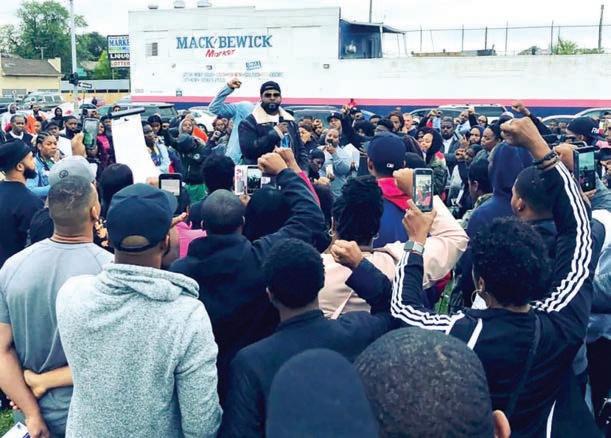
The rise in visitors to the Greektown area is evident in data from Placer.ai, a location analytics company specializing in visit trends and demographic insights through geolocation-enabled mobile devices. From May 1-Aug. 27, 2022, there were 1.3 million visits and 655,000 visitors to Greektown, according to Placer.ai. In the same period this year, these numbers increased to 1.4 million visits and 670,000 visitors.
As Detroit’s downtown area continues to attract both residents and visitors, the police department has implemented various enforcement measures to manage the increased population. Notably, metal detectors have been strategically placed throughout Greektown to deter the illegal carrying of firearms.
because of discrimination, but they were also coming because Black people was doing some stuff. When did Black people start doing things in the city? They started doing things in this area in the 1800’s. In the 1800’s the major thing that they were doing in Detroit is they were the leaders in the fight against slavery.
“We have strategically placed them at key points, “ Chief White explains. It has been a deterrent for some, and some have tested it. If you are legally carrying a weapon and carrying a CPL, have a great day. If you’re
of
and
From page A-1
ZW: I mean the more resources that we’re able to get our hands on, the more resources we’re able to get out to the community, you know what I mean? We take that real serious. So with our engagement numbers being so high, if we have the resources to take them to the doorsteps, it puts us in a position to empower the neighborhoods and the community. Essentially, that’s what all of this is about. That’s what we stand for as an organization and as a community – that, and holding people accountable for doing more.
MC: Detroit is in a hotly contested mayoral race this year where we’re going to have a new leader for the first time in 12 years. We heard Mayor Mike Duggan in his final state of the city address talk about all of the great things that are happening in the city. What’s your perspective on the state of Detroit right now?
ZW: I think there’s a lot of positive going in the city. You probably wouldn’t have got that answer out of me five years ago, but I think that the city is moving in the right direction (even though) it’s still a lot of work to be done, particularly in the neighborhoods and being able to get those resources directly to the people in the neighborhood.
When you think about the difference between Black communities and the suburbs, the biggest difference is the lack of resources. Good schools, good neighborhood programs. For us, we have to really focus on getting those resources to the community and also engaging. We gotta shift the energy in our neighborhood. So I always tell people we work on some of the silent things that you might not see on a scoreboard: morals, ethics, code, respect. We have to have an understanding of taking care of ourselves and holding ourselves accountable, so when it comes to holding other people accountable, we got our stuff together.
MC: You said that the answer you just gave wouldn’t have been your answer five years ago. What’s changed to make you have a different perspective?
ZW: The work. We’re in our 11th season and I know how much impact and influence we’ve been able to have as an organization on the ground. I can even go further than five years ago when we first started. It was a real dark place to be here. Nobody was speaking positive. Nobody was doing positive things in the city. It was just a huge void. Now we’re getting more people active and I hear more people who aren’t just talking, but actually doing something positive…. That wasn’t the case 10 years ago. So I can just look at the energy shifting – the people wanting to do more out in our communities. And I can attest to that, saying ‘OK, this is a positive message. This positive motion.’
We’ve seen a huge decrease in crime and violence in the areas that we work in. For us, we shift the energy and work on the environment and the people in it – hold people more accountable for standing up and doing more. We just gotta get more people involved.
MC: How do you do that?
ZW: Engagement. We live in an era where you can talk people’s head off without doing the work. The good thing about our organization is that we come from a perspective of actually being able to do the work. We teach from the art of doing. It’s easy to be charismatic and get behind a podium and tell people ‘We got to do this,’
From page A-1
What was lost wasn’t just physical space — it was Black generational wealth, economic independence, and cultural identity.
Now, nearly 60 years later, MDOT is proposing to replace that freeway with a surface-level boulevard. The I-375 Reconnecting Communities Project is slated to begin construction this year, and MDOT says the project will “reconnect neighborhoods, improve safety, and honor the legacy of the displaced.” But beneath that promise, a deeper conversation is unfolding: Is this about repair, or is it about redevelopment?
The new plan outlines a six- to nine-lane boulevard with pedestrian access, bike lanes, and signage honoring Black Bottom and Paradise Valley. MDOT says the boulevard will improve traffic flow and increase access between neighborhoods and downtown. But many residents and community advocates aren’t sold on the idea.
For Evans, his concern hasn’t faded. Talking to Michigan Chronicle after he delivered this year’s State of the County address, Evans reiterated his position.
“I think they need to reimag-
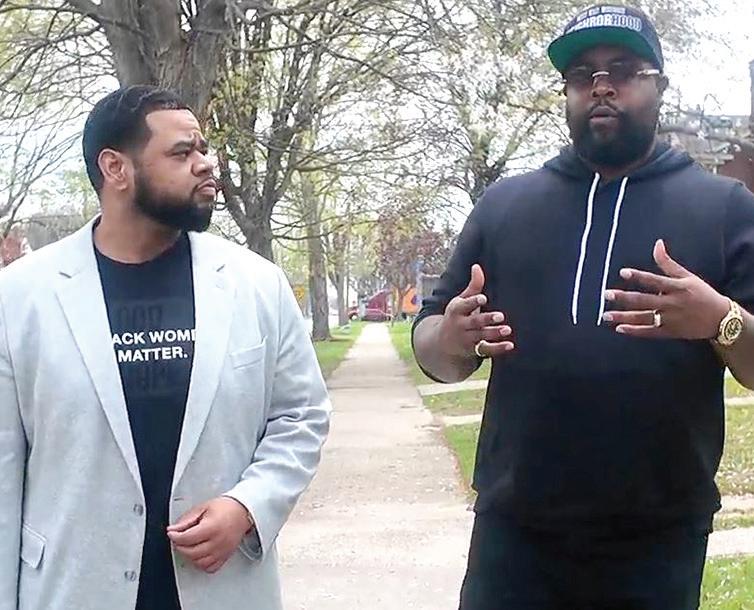
or ‘We need to do that.’ But showing and proving? Being able to get out on the block – out in the community? That right there is the type of leadership that is going to help change the whole landscape of our neighborhoods and our community. The more people see, the more people will do. We been doing this work for the past 40, 50 years, and a lot of it has been without the action.
MC: How do you demand that action from the next group of city leaders?
ZW: Accountability. We gotta be able to check track records. I want everybody to do their due diligence and see the things that they’ve done in the past. Not empty promises. We shouldn’t just look at what you’re telling us that you’re going to do. Let’s check out your background. Let’s see some paperwork. What have you done? What have you contributed over the past five to 10 years to the city of Detroit? That’s very important. Some people that jump in these races haven’t done a lick of work and then talk about. You can’t come from a bare minimum space and want to lead. We can’t play around with this. We got a $2 billion budget. That’s a lot of money. That’s a lot of resources. So you gotta be (community focused) and business-minded and you gotta have a true balance and then making sure you able to connect the two. The person that’s able to connect the two the right way and make it make sense should be the candidate to lead the city.
MC: What do you think should be the number one issue that the candidate tackles if they are elected?
ZW: Once again, resources. What’s more important than being able to get resources in every Black community? We don’t just work here in the city of Detroit. We work in just about every Black community across the country and one thing that I do know is that in every Black community, we deal with the exact same thing. And then the reason that we have so many hoods and ghettos is because we were placed in these environments with a very lack of resources. So until we get the resource aspect together you know, we’re going to continue to see the same things in our community.
MC: What’s the next era for New ERA?
ZW: Business opportunities, man. You know, for us, we look at a lot of these nonprofits and we look at a lot of these people – they get a lot of this funding that we never see. And we know they’re not out here doing our work, but they get millions upon millions of dollars to serve our communities. You know, we want to be a part of
ine it two or three more times.
I’m not convinced that it makes a whole lot of sense. They marketed it as somehow ‘reparative’ – to do something for getting rid of Paradise Valley and Black Bottom. I haven’t seen that anywhere. It’s the biggest scam I’ve heard in a long time. Don’t tell me you’re doing something to benefit people who look like me, and then have no plan to do anything for people who look like me.”
Community members, urban planners, and grassroots leaders have raised similar concerns. Some want reparations built into the project. Others have pushed back against the scale of the boulevard, warning it could further fracture the area instead of healing it. A few have asked for the highway to remain until a more just plan is developed. But one message stands out: those originally displaced and those still living nearby must have the power to decide what happens next.
MDOT has said the project began taking shape in 2014 when safety concerns about the outdated freeway infrastructure became urgent. A collaborative study led by the Detroit Economic Growth Corporation (DEGC), along with
that pie. We understand how it works now. A lot of times when we talk about our people in our community, especially in the nonprofit space, we just skipped over because they think that our paperwork is not good or that we don’t know how to handle a certain amount of money or, because we’re not in the ‘good ol’ boys club.’ And really, that has always put a hinderance on us when it comes to the right organizations getting the right resources and the right funding to provide for the community the right way. So for us is being able to be in those rooms and spaces, we want to be the biggest. We want to be able to compete and continue to level up quickly to really reach everybody in the city and get resources to the doorsteps of people who need them the most.
MC: What would you think is in store for the city of Detroit over the next four or five years?
ZW: I see good things, man. I think that it’s good that we’re about to have a fresh start with the mayor. See, I think that’s always good in politics, in general. No matter how good of a job somebody is doing, it should always be an opportunity for fresh new leadership. After so long, I feel like that’s where we really fall off in politics. When you look at Congress, you got some of these people that’s been there for decades. Like, how are we benefiting people? Y’all don’t even understand the new, fresh ideas that’s coming up. That’s a big problem not only in politics, but in leadership as a whole.
We shouldn’t still be looking at like the Al Sharptons and Jesse Jackson and stuff like that. With all due respect to anybody that’s put in work in the past, it’s a new era. You feel me? There’s new, fresh ideas. And disconnect is a real thing. No matter how honorable you are, the older you get, you’re going to lose connection – especially if you’re not living in the neighborhoods and not tapped into the source. You’re going to lose connection, and then you’re not really going to know how to adequately move or make the right decisions based on the people. So I think that is good that we going to have a new, fresh face, not only in the mayor’s seat, but city council is going to have some fresh faces. I’m looking forward to the next five years in the city. I’m a firm believer that our worst times are behind us…no matter who’s in the seat.
MC: I appreciate you, man. Thanks for taking the time to share your thoughts and perspectives with us.
ZW: My man. Appreciate you, brother. Real talk.
MDOT and the Detroit Riverfront Conservancy, evaluated alternatives. By 2016, six options were on the table. After more than 119 engagement sessions, a final plan emerged. Even after the initial set of “final plans” was made, MDOT continued holding public engagement sessions to gauge the public’s perception of the project.
In 2022, U.S. Transportation Secretary Pete Buttigieg visited Detroit to announce a $104.6 million federal grant for the project, calling it part of a national “reparative process.” The City of Detroit backed that messaging. However, MDOT itself has not echoed the term “reparative,” choosing instead to say it will “pay tribute” to the displaced communities.
It says the removal of the freeway will create 30 acres of land and unlock economic potential. But the questions remain: Who benefits from that land? Who shapes the development? And who gets left out again?
To address historical injustice, MDOT points to four pillars of its approach: Transportation for All: This focuses on improving safety and access for pedestrians, cyclists, public transit users, and drivers, based on concepts developed through the environmental review.
life-altering charges.
A House Fiscal Agency analysis of Michigan’s pilot program using SoToxa machines revealed mixed findings. While more than half of the tests were positive for THC, the majority of results for opioids and methamphetamines were negative. That data raises deeper questions about what substances are truly being targeted and who is most likely to be impacted by enforcement.
Indiana started using similar tests back in December 2020. Since then, 6,543 oral fluid tests have been administered. Nearly half — 3,173 — were positive for THC. Critics argue that those numbers shouldn’t be accepted at face value. THC in saliva doesn’t confirm intoxication; it confirms presence. That’s a distinction the courts are still navigating, and for many civil rights advocates, it’s a reason to pause, not proceed.
Last month, the Michigan Supreme Court ruled that the smell of marijuana alone no longer counts as probable cause to search a vehicle. That ruling directly challenged a 25-year-old precedent, signaling a new legal understanding in the era of marijuana legalization. “A warrantless search must be based on probable cause and the smell of marijuana is insufficient to support probable cause,” wrote Justice Megan Cavanagh for the majority. Cavanagh, who was joined by Justices Richard Bernstein, Elizabeth Welch, Kyra Harris Bolden, and Chief Justice Elizabeth Clement, added that smell alone could not justify further police action.
The court made clear that marijuana possession, within legal limits, is not a criminal offense — nor should it be treated like one. That case centered on a 2020 Detroit parole compliance check, where police claimed to smell burning marijuana coming from a parked Jeep Cherokee. Despite the vehicle’s occupants denying they had smoked, police ordered them out of the car. A handgun was later found under the passenger seat, leading to felony charges. The state’s highest court reversed those charges, stating that the presence of marijuana smell alone no longer provides a reasonable basis for police to conduct searches.
Cavanagh clarified that marijuana use and possession are still not permitted under every circumstance. Driving while under the influence of marijuana remains illegal. “Although the smell of marijuana is no longer sufficiently indicative of the presence of contraband or illegal activity, that does not mean that the smell of marijuana is irrelevant to developing probable cause concerning illegal activity,” she wrote.
Justice Brian Zahra dissented, stating that lower courts may have failed to account for other visible factors that could have established probable cause.
Still, this ruling underscores the shifting legal landscape and makes BeGole’s push for oral testing even more contentious. Police officers have already lost one long-relied-upon tool to justify stops and searches. Replacing that with rapid-response saliva tests could become the new pathway to circumvent probable cause, with communities of color bearing the brunt.
Marijuana laws have evolved, but the legal system’s treatment of Black drivers hasn’t always kept pace. Racial disparities in traffic stops, searches, and arrests have been documented across the country. Michigan is no exception. Adding a flawed testing device that delivers questionable results to that equation risks compounding injustice under the banner of road safety.
Even the framing of the bill reveals the tension. BeGole calls the device “just a tool.” But in a justice system where tools often double as weapons, Black Michiganders have reason to be skeptical. Tools, when misused or misunderstood, become traps.
That’s why lawmakers, researchers, and advocates alike must grapple with more than just road fatalities. They must ask who gets stopped. Who gets tested. Who ends up in court. Who loses jobs, custody, housing, or future opportunities because of a test that wasn’t built with precision, fairness, or context in mind.
If Michigan wants safer roads, it must also want a more equitable justice system. Technology can’t serve as a shortcut through the complex layers of substance use, public health, legal precedent, and civil rights.
Policing can’t rely on guesswork masked as science. And public policy can’t move forward without ensuring communities of color won’t be dragged backward.
Before Michigan decides whether roadside saliva testing becomes law, it owes the public a clearer, more honest conversation about the cost — not just in dollars, but in dignity.
Small Business Enterprise and Workforce Development: MDOT says work is underway to ensure local minority-owned businesses and Detroiters have access to construction and design contracts. Community Enhancement Plan: The department pledges to coordinate with partners on cultural recognition, stormwater management, and connectivity improvements. This plan also intends to reflect community voices.
Neighborhood Framework Plan: Led by the City of Detroit, this plan addresses how land reclaimed from the freeway will be used. Zoning and design standards are still under discussion, with public engagement ongoing.
MDOT says the project is expected to be completed by 2029. The agency promises to work with a local advisory council and continue community outreach. “MDOT continues to welcome feedback from everyone who lives, works and plays in the surrounding area. The project team continues to meet individually with residential groups, businesses, and all stakeholders who solicit the department for information,” the department shared.
But intentions alone cannot substitute for power-sharing.
The language MDOT uses centers on safety and connectivity.
“Fundamentally, this is a safety project designed to enhance mobility and access for all. MDOT continues to strive to create a corridor that creates environmental benefits for the surrounding neighborhoods and business community,” the department stated.
“I might not be opposed to the 375 project if I knew where it was going to be inclusive. I think they’re keeping (parts of) it a secret and I don’t like secrets,” Evans explained.
The department says it wants to honor the past. But honoring means more than acknowledgment. It means action rooted in repair, not revision.
As MDOT advances its vision of safer streets and improved mobility, the community’s call for deeper restoration cannot be minimized. There is a real opportunity here to confront a painful past with courage and clarity. To those leading this reimagining: lean into the discomfort, engage with the memory, and meet the people where they are. Sixty years ago, families were given 30 days to vanish. Today, the charge is to listen, to build with – not for –the people still standing on that soil. That’s how you begin to stitch together what was torn apart. That’s how you reimagine — and reclaim — a future worthy of Detroit’s legacy.


The Comerica Hatch Detroit Contest by TechTown, the small business competition behind many of Detroit’s most popular neighborhood storefronts, has unveiled its Top 10 semifinalists. These entrepreneurs are going head-tohead over the coming weeks, competing to win $100,000 in startup funds from Comerica Bank to open a brick-and-mortar storefront in Detroit, Hamtramck or Highland Park.
The 2025 semi-finalists include: The Coloring Museum, Cone Vecinos, Detroit Culture & Clay, Evelyn’s Midtown Kitchen, For the Love of
Cheesecake, Halie & Co, Livy’s Sweet Rolls, Que Shebley and Walter Pat’s Bakery Cafe
Public voting to narrow the 10 semifinalists to four finalists began Friday, May 16, and runs through Friday, May 23, at 11:59 p.m. Community members can vote for their favorite businesses once per day by visiting HatchDetroit.com.
The four finalists of the 2025 Comerica Hatch Detroit Contest by TechTown will be revealed on Tuesday, May 27, with the final round of public voting beginning on Monday, June 2, at noon and running through the completion of the pitch com-
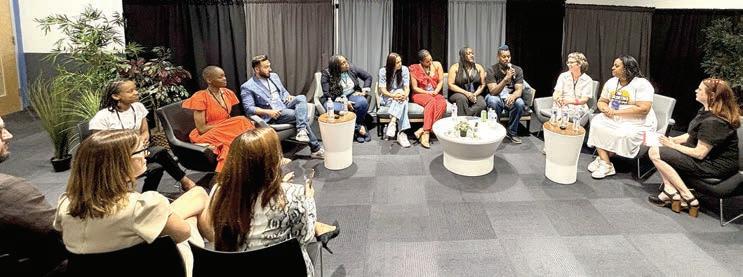

petition at “Hatch Off” on Wednesday, June 11.
“The neighborhood voices of our community have long been instrumental in shaping Detroit’s small business landscape, and the Comerica Hatch Detroit Contest by TechTown is no exception,” said Christianne Malone, Assistant Vice President for Economic Development at Wayne State University and Chief Program Officer of TechTown Detroit. “This city’s entrepreneurial spirit shines brightest when ignited by the passion of its people. Through this contest, we witness how strong community support can elevate a single storefront into a catalyst for neighborhood revitalization, and we’re proud to be a proven launching pad for these small business owners.”
Over the years, the Comerica Hatch Detroit Contest by TechTown has helped create some of Detroit’s most successful and well-known businesses, including winners G.L.A.M Body Scrubs (2024), Bouncing Around The Motor City (2023), Little Liberia (2022), 27th Letter Books (2019), Baobab Fare (2017), Meta Physica Massage (2016), Sister Pie (2014), Batch Brewing Company (2013)
and La Feria (2012). With this year’s contributions and grants, Comerica and Comerica Charitable Foundation have invested $1.3 million into Hatch Detroit since it first began supporting the small business program in 2012.
2025 Hatch Off
The contest will culminate with the annual “Hatch Off” where the Top 4 entrepreneurs present their business plans in front of a panel of expert judges and live audience. The winner of the 2025 Comerica Hatch Detroit Contest will be chosen through a combination of the public’s vote and judges’
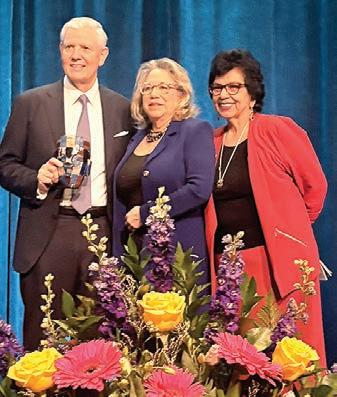

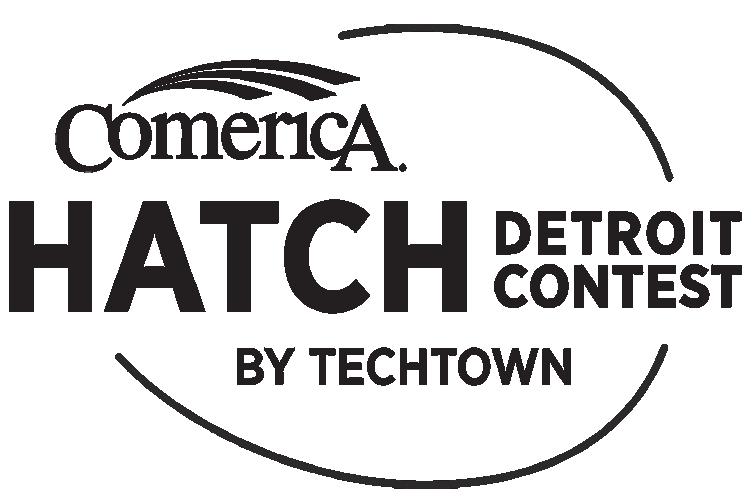
The Coloring Museum (owner: Sherrie Savage): The Coloring Museum harnesses the power of the crayon to bring community collaboration, spark creativity, and promote mental wellness. Through vibrant events and interactive experiences, residents and guests color black-and-white murals illustrated by local artists. Each mural becomes a collective masterpiece, transforming simple lines into colorful stories celebrating connection, self-expression, and the healing power of art therapy.
Cone Vecinos (owner: Ellen Donnelly): Every neighborhood should have a beloved ice cream shop. Cone Vecinos aspires to be an anchor for the Morningside community with a simple concept: soft serve ice cream + friends. Cone Vecinos will bring together all ages, all walks of life to enjoy a no-frills treat with neighbors and newcomers alike.
Detroit Culture & Clay (owner: Centurium Frost): Detroit Culture & Clay is a one stop for all things clay. Guests can enjoy paint and sips, hands-on learning and a full stock of ceramic supplies, while also supporting local artists by purchasing their unique work.

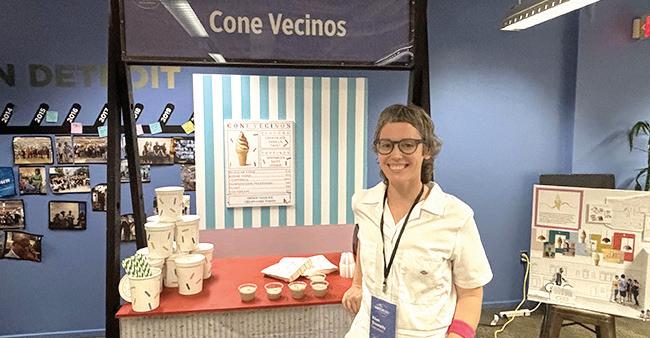
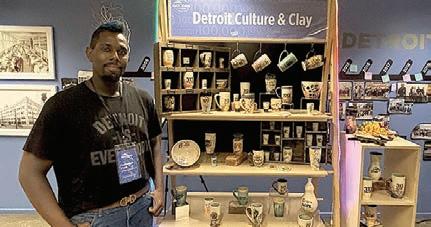
Evelyn’s Midtown Kitchen (owner: Evelyn Stokes): Evelyn’s Midtown Kitchen offers immersive, hands-on cooking classes that spark joy, build confidence, and foster community. From youth camps to date nights and global cuisine workshops, Evelyn’s Midtown Kitchen defines their mission as, “Serving Detroit and beyond with accessible, culturally rich experiences that create connection, celebrate diversity and make culinary education a joyful, empowering tool for community impact, growth, and meaningful engagement.”

For the Love of Cheesecake (owner: Courtney Hamilton): For the Love of Cheesecake crafts exceptional, fully customizable cheesecakes using premium, locally sourced ingredients, while uplifting the Detroit community through job creation and entrepreneurial support. Extending beyond cheesecakes, For the Love of Cheesecake empowers local women and students with flexible employment and fosters economic growth by providing shared commercial kitchen space to help emerging food entrepreneurs build and scale their businesses. Halie & Co (owner: Halie Conyers): Halie & Co is a handmade jewelry, candle, and home fragrance store with the belief that everyone should have access to affordable jewelry and goods that make them feel beautiful and are created with high-quality materials and intention. Halie & Co creates experiences through permanent jewelry and jewelry making workshops, giving customers the perfect way to be a part of the creation process.


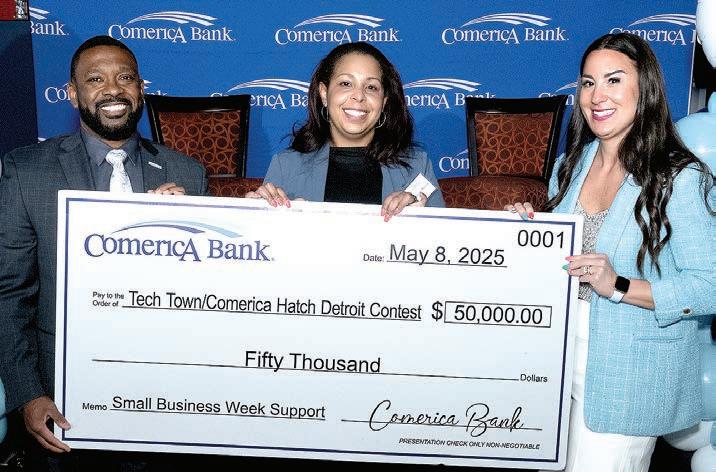
Comerica Bank Swings Big to Support Small Business Growth with $250,000 Contribution to Community Organizations
TechTown Detroit among small business community Incubators that received $50,000 for assisting entrepreneurs
Comerica Bank took a big swing during National Small Business Week (May 4-10) to support small business incubation by contributing $250,000 to community organizations focused on entrepreneurial development, growth, education and empowerment.
The five nonprofit organizations, each received a $50,000 contribution from Comerica Bank, include: Impact Ventures (Dallas, Texas), Pacific Asian Consortium in Employment (Los Angeles, Calif), TechTown Detroit (Detroit, Mich.), Women’s Business Enterprise Alliance (Houston, Texas), and Working Solutions CDFI (San Francisco, Calif.).
Comerica’s $250,000 contribution kicked off its week-long celebration of small businesses featuring customer and community-focused activities.
“Delivering on our commitment to small businesses in the communities we serve remains vital to strengthening families, supporting neighborhoods and bolstering local economies,” said Omar Salah, Comerica Bank Executive Vice President, Small Business Banking Director. “Our community organizations have become valuable and necessary resources for entrepreneurs and small business owners, as they understand the needs of those they assist daily and the barriers that must be overcome to help them open doors to paths of prosperity.
“National Small Business Week reminds us of the year-round impact and value of our customers, community organizations, and entrepreneurs at-large who passionately believe in a better future through small businesses.”
Additionally, each nonprofit organization was honored as special guests during a check presentation at Comerica baseball-themed small business events in Detroit, Dallas, Houston, Los Angeles and San Francisco. According to the U.S. Small Business Ad-
small businesses in the
as of
a 4.5% increase from the previous year. Small businesses continue to serve as the growth engine of our economy as they employ about 59 million employees.
Since 2022, Comerica Bank has proactively strengthened and expanded its commitment and support for small businesses to enhance small business growth across its markets. This includes establishing dedicated small business
Along
“When engaging our communities and small business customers, we strive relentlessly to offer them innovative, value-added experiences that go well beyond traditional banking services,” said Jim Weber, Comerica Bank Executive Vice President and Chief Experience Officer. “By sharing the kinds of resources and tools typically
ning Comerica BusinessHQTM in the southern sector of Dallas, providing collaborative space to high-need, high-opportunity small businesses, as well as the necessary tools to develop, grow and endure.
Comerica and Detroit Tigers Step Up to the Plate for Metro Detroit’s Small Businesses

Livy’s Sweet Rolls (owner: Myra Thomas): Livy’s Sweet Rolls specializes in handcrafted gourmet cinnamon rolls made from scratch with nostalgic, high-quality ingredients. Inspired by a family tradition of wholesome baking, Livy’s Sweet Rolls offers better-for-you desserts free from preservatives, dyes, and artificial junk. Its mission is to spread joy through premium sweet treats that families can trust, enjoy, and create memories around.
Que Shebley (owner: Que Shebley): Que Shebley is a luxury fashion brand founded by Lebanese-American designer Que Shebley. Merging heritage with innovation, the brand is launching a world-class flagship in downtown Detroit, a fusion of bespoke tailoring, cutting-edge tech, and a high-fashion café. From handcrafted shoes to custom suits, Que Shebley offers a bold new take on modern elegance and self-expression.

The Spiced Bar (owner: Dominique Hankins): The Spiced Bar is Detroit’s first full-service flavor destination. Guests create custom spice blends, sip bold drinks at a spice-forward beverage bar, and explore globally inspired small bites—all in one immersive space. It’s where curiosity meets culture, and flavor becomes a form of self-expression. Crafted for Detroit. Made to be unforgettable. Walter Pat’s Bakery Café (owner: Lauren Ellis): Walter Pat’s Bakery Cafe is a seasonally driven, small-batch, black woman-owned bakery in Detroit. The cafe focuses on Michigan seasonal produce and specific flavors from Midwest upbringing and southern influence. Walter Pat’s strives to showcase unique flavor combinations and delicious classics, as well as to broaden taste buds with a new experience through food.



On May 11, Comerica Bank and the Detroit Tigers commenced their 2025 Small Business of the Month program that recognizes metro Detroit small businesses and provides valuable resources to promote services and brands to a wider audience. The Tigers Comerica Bank 2025 Small Business of the Month launched just after the conclusion of National Small Business Week (May 4-10) and featured Rent A Bounce as its first honoree.
The Small Business of the Month receives ingame exposure on Comerica Park’s LED ribbon boards and scoreboard, in addition to promotion on both Comerica and Tigers social media channels. Each small business participating receives suite access during the game to entertain clients, prospects or employees.
“We value small businesses and the extensive impact they have on our local economies,” said Meghan Storey, Comerica Bank Senior Vice President and Michigan Director of Small Business Banking. “As we celebrate their successes and contributions to our communities, we want to further assist in their growth and reach by delivering valuable assets through our Small Business of the Month program with the Tigers at Comerica Park and on social platforms.”
Rent A Bounce, based in Sylvan Lake, is a premier party rental company specializing in inflatables, tables, chairs, and tents for events big or small. The service area for Rent A Bounce reaches throughout Oakland county and areas in Wayne and Macomb counties. For more information, visit www.rentabounce.com.
Additional Comerica Bank Small Business of the Month honorees include: Encore Commercial Products (Farmington Hills) on June 7, Leonardo Marble & Granite (Wixom) on July 12, Murray’s Worldwide (Oak Park) on Aug. 23 and Doetsch Industrial Services (Warren) on Sept. 20.

Comerica’s commitment to small business is enhanced through its partnerships with Detroit pro sports teams and allows small business customers to leverage valuable and unique resources to gain exposure, build their brand and reach larger audiences. In addition to the Small Business of the Month program with the Tigers at Comerica Bark that first began in 2021, the bank has also partnered with the Detroit Lions on the Comerica Bank Small Business of the Game since 2017 and with the Detroit Pistons via the SHOP313 PopUp Shops presented by Comerica Bank, which recently completed its second season.
Including those featured in upcoming
A5 | May 21-27, 2025
How FHA Mortgages Create Pathways to Ownership
In America, homeownership remains one of the most powerful ways to build generational wealth. But for far too long, the path to that dream has been blocked especially for Black and underserved communities. From redlining to discriminatory lending practices, these barriers have made it harder for families to own a piece of this country. In this country, wealth has always been tied to land and property. But when you’re locked out of ownership, you’re locked out of opportunity.

That’s why the Property is Power movement exists to dismantle those barriers and create pathways to ownership that are equitable, accessible, and transformative
One of the most powerful tools to help achieve that goal is the FHA mortgage. It’s not just a loan product, but as a bridge to opportunity.
An FHA loan isn’t just a loan. It’s a launchpad, a practical, proven way to help first-time buyers, especially in historically excluded communities, become homeowners. It’s a tool that says, “You belong in this conversation. You deserve a stake in this country. And here’s how we help make that possible.”
What is an FHA Loan?
An FHA (Federal Housing Administration) mortgage is a government-backed loan designed specifically to help first-time and lower-income buyers become homeowners. With low down payment requirements, more flexible credit guidelines, and competitive rates, the FHA loan opens doors that might otherwise remain closed. Why FHA Loans Are a Game-Changer:
• Low Down Payment Requirements
• Buyers can put down as little as 3.5% a huge win for families without generational wealth or large savings.
• Flexible Credit Standards
FHA is designed to work with people who have less-than-perfect credit, making homeownership possible even for those recovering from financial setbacks.
• Assumable Loans
FHA loans can be transferred to a new buyer when you sell giving you a unique advantage when rates are high and helping others access affordable financing too.
• Pathway to Stability and Equity
Instead of paying rent and building someone else’s wealth, FHA loans let you invest in your future growing equity and financial security for yourself and your family.
Bridging the Gap
The Black homeownership rate still lags 30 percentage points behind white households. That’s not just a statistic, a reflection of lost opportunity, lost equity, and systemic inequality. FHA loans were created to expand access, and when used correctly, they can help close this gap.
Why it Matters
Because when more Black and families become homeowners:

By Ebony JJ Curry SENIOR REPORTER
Detroit has always known what it means to build. From laborers on the line to masons laying brick in the bitter cold, Black hands have shaped the foundation of this city. But when it came time to lead the development, own the contracts, and control the future? Too often, we were left standing on the outside looking in.
That’s what makes the launch of Invictus Builders LLC more than another business opening. It’s a line in the sand. Two longtime Detroit-area construction executives, Matt Evans and Kent Jackson, have stepped forward—not as subcontractors or support—but as founders. As owners. As the decision-makers.
The firm, headquartered in Detroit’s Central Business District, is not here to blend in. Its name, Invictus, means unconquered. And for Evans and Jackson, this firm is more than a business—it’s a statement about legacy, power, and responsibility in a city that has seen enough broken promises in the name of “development.”
Evans, now serving as CEO of Invictus Builders, brings years of executive leadership and a deep history of community development. He’s not new to this. He’s led programs inside Detroit schools, training students to design and install solar panels—real skills, real access. Jackson, a Detroit native with three decades of construction management experience, now serves as COO. He’s managed projects in education, healthcare, industrial, and commercial sectors. He’s not stepping into new terrain—he’s claiming what’s already been built through years of mastery.
Together, they formed Invictus to shift the culture of development in Detroit and across the Midwest.
“Our team’s experienced construction professionals and community leaders bring
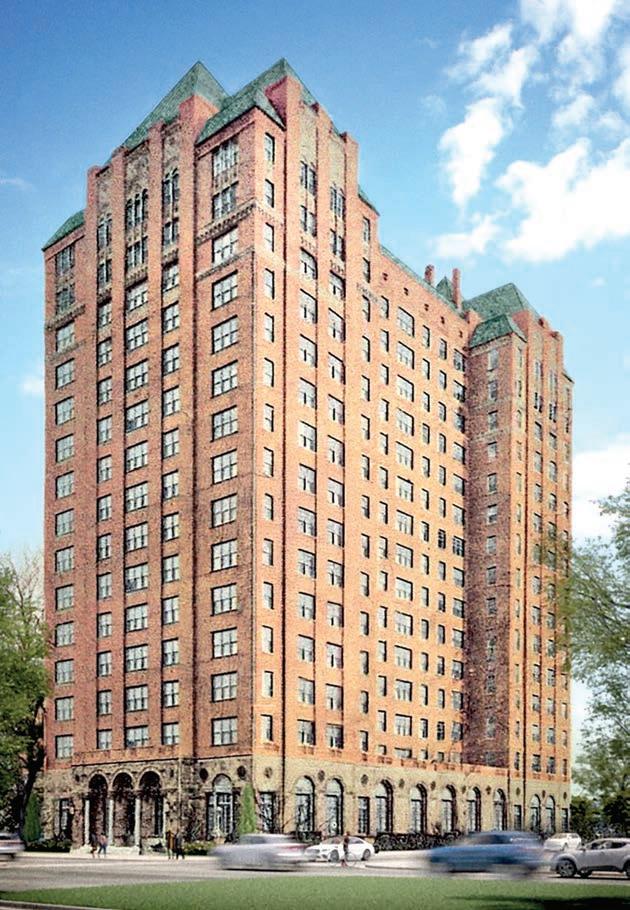
a wealth of knowledge and creativity in construction management, and business and community development,” said Jackson. “We are here to foster opportunities for young people—a place where a young professional can come and grow fast in the business.”
That vision isn’t being executed alone. Evans and Jackson have assembled a board that reflects strength, reach, and strategy.
Dennis Archer Jr., founder and chairman of sixteen42 ventures, leads the board. Archer’s name is synonymous with Detroit innovation—his leadership brings both business insight and cultural integrity.
“Invictus was formed from a vision to create opportunities and strengthen communities while fostering a culture of excellence in performance, innovation and inclusivity,” said Archer. “With unparalleled expertise, the team takes pride in the commitment to building sustainable spaces that empower our team, clients and community.”
Joining him is Mike VanGessel, a foundational figure in West Michigan development. After 38 years with Rockford Construction, VanGessel stepped away to launch VanGessel Investments and now serves on the Invictus board.
“After being an integral part in shaping downtown Grand Rapids from where it was over 20 years ago to where it is today, I’m excited to bring proven solution-driven strategies and framework to Invictus and the clients and communities we serve,” said VanGessel.
The board is further strengthened by Eric A. Reeves, founder of Prospect Park LLC in Chicago, and Rachel Scott, managing member of SPARC Investments in Cleveland. This isn’t a ceremonial board— it’s a powerhouse of leadership across the Midwest, bringing decades of investment and construction experience into one room.
And the projects are already moving. In-
victus is managing work for Wayne County Community College and Parkstone Development Partners in Detroit. Their current portfolio also includes developments at Back Nine in Clarkston and 1515 Madison in Grand Rapids. These aren’t symbolic wins. These are proof points. Invictus is active, competitive, and fully capable. Evans, who leads strategy and client development, understands the timing.
“With the tremendous excitement and energy happening in Metropolitan Detroit, we feel that Invictus is uniquely situated to build opportunities for not only southeastern Michigan, but in communities throughout the state and the Midwest,” said Evans. “We’re excited to bring two high-level leaders from both sides of the state—Dennis Archer Jr. from the eastside and Mike VanGessel from the westside—to push our vision forward and approach each project with expertise and integrity.”
This pairing is intentional. Detroit and Grand Rapids have often moved on separate tracks when it comes to development. By bridging these regional leaders, Invictus positions itself to reshape the construction narrative across the state.
Still, location matters. Invictus is based in the heart of Detroit. That decision anchors the firm in the city’s current and future transformation. The company offers construction management, general contracting, consulting, and pre-construction estimating services. But what separates Invictus is not just what they offer—it’s how they operate.
The company is grounded in a principle that has been missing from too many past projects: the belief that development must empower the people closest to it. That belief shows up not just in hiring, but in mentoring, in leadership cultivation, and in how Invictus sees itself as part of De-
117 Units of Senior Affordable Housing Planned in $60M Transformation of Historic Landmark
By Amber Ogden STAFF WRITER
After nearly 30 years of vacancy, Detroit’s iconic Lee Plaza is poised for a dramatic return to life.
Construction officially began this week on the long-planned restoration of the 15-story Art Deco tower on West Grand Boulevard, marking a major milestone in one of the city’s most ambitious historic redevelopment efforts to date. Once a symbol of opulence and later of decay, Lee Plaza will soon offer 117 units of affordable senior housing and signal a broader wave of neighborhood revitalization. At a groundbreaking ceremony Tuesday, over 100 community members, civic leaders, and project partners gathered at the base of the once-grand structure to celebrate the start of construction. The redevelopment is being led by The Roxbury Group, Ethos Development Partners,
and Lighthouse, in partnership with the City of Detroit and the Michigan State Housing Development Authority (MSHDA).
David Di Rita, Principal of The Roxbury Group, highlighted that this is the culmination of a seven-year effort in collaboration with the City of Detroit and the State of Michigan.
“We at Roxbury, Ethos, and Lighthouse feel honored to be the stewards of this incredible restoration effort. Today, we proudly begin the redevelopment of Detroit’s last vacant high-rise,” Di Rita said.
Originally opened in 1929 as a luxury residential hotel by developer Ralph T. Lee, the building has long captivated Detroiters with its ornate design and tragic decline. Now, the $60 million restoration project will breathe new life into the building, with units dedicated to seniors earning at or below 50% of the area median income. Rents will be capped at 30% of a resident’s income, and affordability will be guaranteed for at least 45 years.
A planned second phase of the redevelopment is expected to add up to 65 additional units in the building’s upper floors, pending financing.
“Lee Plaza is one of the most beloved buildings in our city, not only because of its architectural beauty, but because it’s in a neighborhood,” Mayor Mike Duggan said.
“Thanks to Roxbury and their partners, Lee Plaza is being transformed from blight to its original beauty.”
Designed in the height of the Art Deco era, the building’s intricate façade and grand interior spaces will be meticulously restored. That includes recreating the original terra cotta lion heads that once adorned the exterior and architectural features that were famously stolen and became national news. Detroit-based Sachse Construction manages construction, with architectural oversight by Fusco, Shaffer & Pappas and preservation consulting from Kidorf Associates.
The project’s financing is a complex public-private collaboration. Support includes Low-Income Housing Tax Credits (LIHTC) from MSHDA, City of Detroit ARPA funds, grants from the Michigan Legislature and MSHDA, and rental subsidies from HUD. Additional
From page A-5
troit’s ecosystem—not above it.
Detroit has been a testing ground for top-down development for decades. Tax incentives, private deals, flashy renderings— none of it means much if the people who live here don’t benefit. Invictus is making a different bet: that integrity, experience, and inclusion can coexist in the same hard hat.
That bet is getting attention. Kevin Johnson, president and CEO of the Detroit Economic Growth Corporation, affirmed what many are feeling.
“We’re excited to welcome Invictus Builders to Detroit’s business community,” said Johnson. “Minority-owned businesses are important to creating an inclusive economy that benefits all Detroiters. Matt Evans and Kent Jackson bring vision and commitment to our neighborhoods. Their impressive leadership team will make a real difference in Detroit’s growth.”
That growth must look different than what we’ve seen. Ownership matters. Decision-making matters. And young Black professionals in Detroit deserve to see what it looks like when Black leadership shapes a company from top to bottom—without compromise.
Invictus is not interested in waiting to be asked to the table. They’re building the table, placing chairs for others, and making sure the work uplifts the communities where it happens. Their story is not about a single project—it’s about a larger commitment to flipping the structure that has excluded too many for too long.
There is no shortage of talent in Detroit. What’s been missing is the infrastructure to lead from within. Invictus Builders is filling
From page A-5
financing and tax credit investments have been secured from KeyBank, Invest Detroit, the Detroit Economic Growth Corporation, JPMorgan Chase, and the Royal Bank of Canada.
MSHDA Executive Director Amy Hovey emphasized that Lee Plaza symbolizes Detroit’s resilience and potential.
“After sitting vacant for nearly three decades, this historic landmark will soon offer 117 affordable homes for seniors,” Hovey said.
“We’re proud to invest in a project that not only breathes new life into this building but also creates lasting impact through safe,
that gap—and setting a standard that says Detroit’s future will be built by those who know its past, understand its people, and are accountable to both.
This firm is not a feel-good story. It’s a necessary one. Detroit can no longer afford to have outsiders lead development while residents watch from the sidelines. Invictus is proving that when experience meets purpose, real change follows.
From page A-5
• Roots in a community
• Children see what’s possible
• A legacy for your children
• Neighborhoods become more stable
• Communities grow stronger
• And the generational cycle begins to shift
• The ability to leverage equity for college, retirement, or entrepreneurship
The truth is, FHA loans won’t solve every problem but they’re a critical piece of the puzzle. They offer families a way in, and for many Black households, that’s all they’ve ever needed: a fair shot.
We don’t just need programs we need policies and products that are intentional about closing the racial wealth gap. That are designed with equity in mind. FHA mortgages are one of the few tools that meet people where they are and walk them toward where they want to go.
Property is Power! and FHA is one key to unlocking it.
Property is Power! is a movement to promote home and community ownership. Studies indicate homeownership leads to higher graduation rates, family wealth, and community involvement.

stable housing,” Hovey said.
Once complete, the project is expected to generate over 200 construction and permanent jobs. It is also expected to have a major impact on the surrounding Northwest Goldberg neighborhood, just west of the New Center area, and improve safety conditions near the neighboring Northwestern High School.
Lucas Visser, Vice President of Historic Tax Credit investments at JPMorgan Chase, echoed the broader significance of the project.
“Our collaboration with





The Roxbury Group, Ethos Development Partners, and Lighthouse is not just about transforming an iconic building into affordable housing,” Visser said.
“It’s about revitalizing the community, preserving Detroit’s rich architectural heritage, and creating a supportive environment for low-income seniors. Together, we’re fostering a vibrant future for the neighborhood and nurturing a sense of pride and belonging among its residents.”
Phase one is expected to be completed by the end of 2026, with the development team actively seeking funding to move forward with the second phase.
For more about the history of Lee Plaza, visit HistoricDetroit.org.
Do you suffer from back or neck pain? Trinity Health has the latest methods and technology to help. Our team looks at many treatment options to create a plan that is right for you. From physical therapy and pain management to advanced spine surgery, say goodbye to living with pain. Reach out to the Trinity Health spine program today and get back to enjoying your daily activities.
TrinityHealthMi.org/Spine


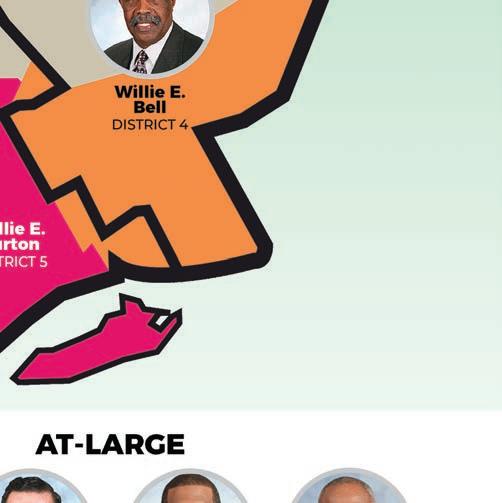
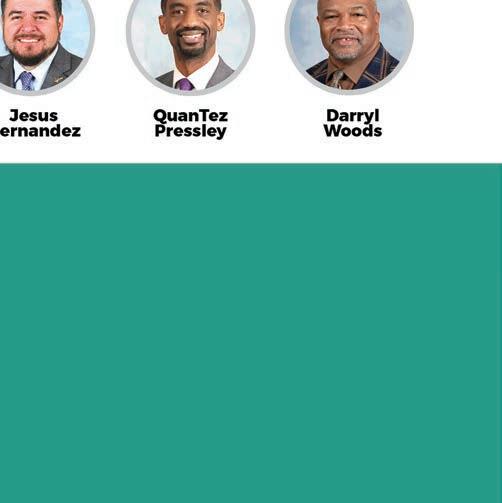

By: Ebony JJ Curry
SENIOR REPORTER
For the second straight year, Detroit’s population has grown.
After nearly seven decades of declining population, these back-to-back years of growth mark a significant turning point for the city’s future and the residents who have long demanded investment that matches their resilience.
New data from the U.S. Census Bureau shows Detroit’s population rose to 645,705 residents as of July 2024, an increase of 6,971 people from the previous year’s total. The new population total moves Detroit up to the 26th-largest city in the country, surpassing Portland, Oregon.
The federal agency also corrected its 2023 count, raising Detroit’s total from 633,218 to 638,914 after years of local pushback over flawed counting methods. Those changes come on the heels of a lawsuit from Mayor Mike Duggan and the City of Detroit, which argued that the Bureau’s formula underestimated housing unit data and disproportionately harmed Black-majority cities.
Duggan, who previously challenged the Census for undercounting thousands of housing units, linked the revised estimates to progress in Detroit’s neighborhoods. “This is driven by people moving into the neighborhoods,” he said during a press conference Thursday. “Now the neighborhoods aren’t being forgotten by the Census Bureau.”
Census data is calculated using a basic formula—housing units multiplied by the average number of people per household. For Detroit, the average is just over two. The lawsuit filed by the city argued that between 2021 and 2022, at least 11,449
By Tricia A. Keith GUEST COLUMNIST
At Blue Cross Blue Shield of Michigan, we understand that affordability is one of the most urgent challenges facing our members, customers and communities. Health care costs are rising too quickly, straining working families, small businesses and insurers alike. That’s why we are diligently working to promote affordability across every part of our business — from modernizing operations to reimagining how care is paid for and delivered across the health care ecosystem.
There’s an urgent need to address these issues now — for hospitals, providers, payers and the people and small businesses that pay for health care. Affordability can’t wait.
Costs are rising at a pace that puts pressure on every part of the health care economy. In 2024 alone, Blue Cross and our subsidiaries paid an average of $100 million per day to cover the care and benefits of our members in Michigan and across the country. That’s why we’re here. But it’s also $12 million more per day than in 2023 and $20
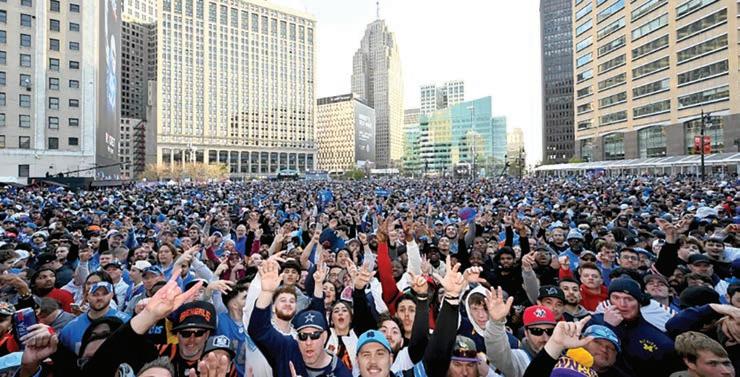
housing units were missed. That oversight may have left nearly 30,000 residents uncounted. The cost of those missed numbers is not just symbolic. It carries a real impact: hundreds of millions of dollars in potential lost federal funding.
In 2020, the Census Bureau acknowledged its methodology undercounted minority cities. The revised estimates now appear to confirm the validity of Detroit’s claims.
The population increase aligns with the Duggan administration’s longtime benchmark for success. From his first campaign forward, Duggan said his time in office should be judged by one question: whether he could stop and reverse population loss. That standard is now being measured with federal data and decades of context.
Detroit’s population collapse followed the mass exit of white families after World War II. Between 1947 and 1963, the region saw 25 new automotive plants open. Not one was located within the city. Instead, General Motors, Ford, and Chrysler chose
Our vision as a nonprofit mutual company is to keep health care accessible, effective and financially sustainable for all Michigan residents. That means we answer to our members, not shareholders. And it means we must operate differently — faster, leaner and more focused on value.
We’re also working with others across the health care landscape to develop the tools, programs and resources that improve quality, efficiency and affordability.
Through our Value Partnerships program, we’ve built strong, lasting collaborations with more than 20,000 physicians and 100 hospitals. These partnerships have reduced health care costs — saving $6.3 billion since 2005 because repeated tests were avoided, complications and errors were reduced, ER visits and hospital stays were prevented, and care was coordinated.
We’re also using advanced analytics and data sharing to help providers close gaps in care, improve coordination and deliver more proactive care. For example, we’re using machine learning and predictive modeling to identify health problems early, which results in earlier care and lower costs for patients and members alike.

million more per day than just two years ago. These costs are driven largely by steeply rising medical and pharmacy claims. Last year, medical claims rose 7.7% and pharmacy claims jumped 14.6%, far outpacing the general inflation rate of 2.9%, according to the U.S. Bureau of Labor Statistics.
As a result, Blue Cross experienced a $1.7 billion underwriting loss in 2024, an unsustainable outcome for any business. Despite that financial strain, we have a strong foundation built on healthy reserves, smart investments, diversified revenue sources and the trust of millions of Michiganians. This allows us to remain a stable, mission-driven organization whose focus never wavers: protecting our members and strengthening the health care system for the long term.
Blue Cross is doing everything we can to absorb as much of the pressure of affordability as possible, including looking internally at our own operations. Our administrative costs account for just 9 cents of every health care dollar, and we’re working to bring that number even lower. We have committed to reducing $285 million in administrative costs in 2025 and a total of $600 million over three years — tangible steps that reflect our pledge to ease financial pressure on members while strengthening the health system overall. But we can’t do it alone. We need to work with our partners across the health system to make care more affordable. Mackinac Policy Conference: A Call for Action
This conversation supports the tenor of discussions at this year’s Mackinac Policy Conference (May 27-30), where the theme is “The Equation for Impact: (Vision + Tools) x Action = Impact.” It’s a call to move from intention to innovation. At Blue Cross, we’re answering that call, taking measurable steps to drive down costs and bring greater value to the people we serve.
the suburbs, accelerating disinvestment and stripping the Black workforce of opportunities. More than 143,000 jobs disappeared, taking with them the stability that once defined Detroit’s working class.
As white residents moved out and industry followed, Black Detroiters were locked out of suburban development. Racist housing covenants, predatory lending, and redlining practices corralled Black families into limited sections of the city. Many were pushed into neighborhoods like Black Bottom and Paradise Valley, which were later destroyed through government-led urban renewal projects.
By 1960, unemployment among Black Detroiters reached 18.2%. Among Black youth aged 18 to 24, it surged to 30%. At the same time, white unemployment in the region hovered at just 5.8%.
Sixty years later, the disparity remains. In 2022, the University of Michigan reported an 18% unemployment rate for Black Detroiters, compared to just 8% for white residents.
Those numbers are more than historic footnotes. They form the backdrop for why population growth now matters, because federal resources are still tied to population size. A growth trend, if sustained, opens the door to stronger infrastructure, expanded job programs, and restored public services in communities that have been overlooked for generations. Growth, if sustained, could lead to larger federal appropriations. More dollars for schools. Expanded access to transit. Greater opportunities for economic development that center Detroit’s most impacted communities. It’s not enough to celebrate growth without addressing how those benefits will be distributed.
Who gets to stay in Detroit as investment returns? Who gets to build wealth? Who will control the direction of redevelopment? These are the questions that matter most to the people who never left. To the families who held on through bankruptcy, water shutoffs, school closures, and land grabs. To the everyday Detroiters who raised generations while waiting for the city to once
again work for them.
The stakes of the data correction extend beyond headline numbers. They determine how Detroit can respond to poverty, housing insecurity, and public transit needs. For a city that is nearly 78% Black, federal miscounts do not happen in a vacuum. They reinforce structural gaps already present in every sector of daily life.
The Census correction and back-to-back years of growth may mark a shift in perception nationally, but Detroiters on the ground have long demanded to be counted. Residents and grassroots leaders have spent years challenging systems that treat their presence as an afterthought. The growth confirms what many in the community already knew—people are staying, returning, and investing in the neighborhoods that have always held the city together.
Still, growth must be paired with equity. The people fueling Detroit’s resurgence are often the same ones who experienced the worst of its decline. A changing count must lead to a policy that centers their needs, not just developer interests or commercial projects disconnected from the city’s roots.
Duggan’s administration credits its blight removal strategy for opening more housing opportunities, but advocates continue to raise questions about how revitalization is defined. Who benefits from demolition? What protections exist for longtime residents as redevelopment accelerates?
Population growth by itself doesn’t solve Detroit’s disparities. But it shifts the ground for what is possible when every resident is accounted for, when neighborhoods gain visibility, and when the federal government acknowledges past missteps.
The national comparison reveals how unusual Detroit’s gains are. While cities like New York, San Antonio, Houston, Fort Worth, and Charlotte led in raw growth, others—Philadelphia, New Orleans, and Memphis—posted population declines. Detroit’s ability to reverse a generational trend while many urban areas are shrinking puts it in a position to shape new narratives about legacy, recovery, and representation.
The population increase signals that more residents are choosing to live and remain in the city. That decision carries weight. It underscores the importance of policy decisions that protect affordable housing, support small businesses, and fund schools, not just for economic growth, but for dignity.
Detroit’s road back cannot be paved solely by mayors or agencies. It moves forward through residents who refused to leave, who organized despite austerity, and who continue to demand a city that works for all. Growth must affirm their presence, not erase their history.
The numbers are official. The count has changed. But the work of rebuilding trust, equity, and opportunity continues—on the same blocks where it all began.

And we’re taking action. We’re not only imagining a better system — we’re building one. Every operational decision, every part nership and every dollar we invest is aligned to deliver value for our members.
That’s why we’ve made the tough choice to reduce internal costs; and that’s why we support programs that reduce health dispar ities, expand behavioral health access and keep maternal health at the forefront.
And through our community partner ships, we’re supporting solutions that help people stay healthier and avoid preventable, high-cost care settings.
Impact: Leading Michigan Forward
At this year’s Mackinac Policy Confer ence, Blue Cross Blue Shield of Michigan is proud to serve as the diamond sponsor, sup porting the conversations and the collabora tions that will lead our state forward.

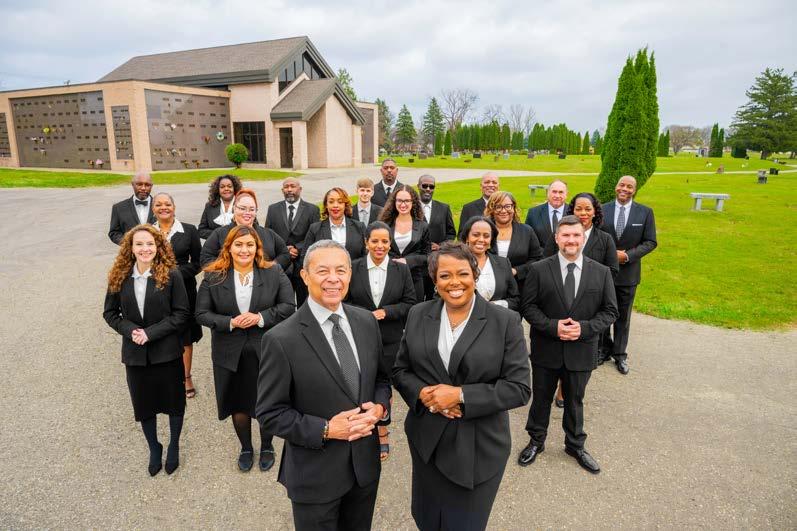
Before joining Blue Cross nearly 20 years ago, I spent several years working in the Michigan Legislature. One of the most powerful lessons I learned during that time came from building partnerships across stakeholders to create change: great things can happen when interests align.
Like the conference theme this year, the health care affordability equation is complex, but we all share the same inter est — the health of our citizens. It will take working together across the health care eco system — including hospitals, providers, pharmaceutical companies and the public — to find solutions. With the right vision and bold action, we’re confident that we can create real, measurable impact for Michi gan, and affordable, sustainable health care for Michiganians.
Tricia A. Keith is president and CEO of Blue Cross Blue Shield of Michigan. For more information about health care affordability, visit www.mibluedaily.com/affordability.

HEALTH CARE IS PERSONAL. SO ARE ITS COSTS.
Perhaps no part of the economy affects each of us as personally as health care. It brings new life into the world. It cures diseases. It saves lives.
It’s also expensive. Your ability to afford health care is essential — and affordable health insurance is a big part of that. As prices for medical services and prescription drugs continue to rise, so does the pressure on health insurance affordability. Last year, our prescription drug costs alone grew 15% — five times faster than inflation. This concerns us, because it pressures your health insurance costs.
We want you to better understand why this is happening. We want you to know everything we are doing about it, including our efforts to lower the costs of running our company by $600 million while we maintain the quality services our members expect.
We want you to be engaged. Informed. Involved in the conversation. Because health care is personal — and we need to make it work for everyone.


As Enbridge President and CEO Greg Ebel is fond of saying, “You can’t run a full-time economy on part-time power.”
In today’s rapidly evolving world, energy demand is growing at an unprecedented rate. This is driven by advances in artificial intelligence, the continued expansion of data centers, and the resurgence of manufacturing across industries. Keeping pace with these demands—and doing so with an energy mix that is reliable, secure, and affordable—requires a comprehensive approach that encompasses both traditional and renewable energy sources. The solution isn’t one-dimensional; it’s multifaceted.
The bottom line? There’s no single energy solution
The reality of energy demand is staggering: Data center energy requirements are set to surpass 1,000 TWh by next year.1 This is a load growth that has tripled in the past decade, with projections to double or even triple again in just the next three years. Semiconductor factories now consume as much energy as an entire town, and global manufacturing capital expenditures are expected to increase by more than 5%.2
Meanwhile, emerging economies are continuing to grow, and they’re contributing to about 85% of the additional global energy demand.1

“It’s our long-held view that growing energy demand fundamentals mean that all forms of energy are going to be needed for decades to come,” says Ebel. “Enbridge’s diversified business mix is ideally positioned to meet this growing demand in oil and natural gas, lower-carbon opportunities, and renewable power.”
Enbridge’s role in Michigan’s energy future
Every day, Michiganders depend on secure, reliable energy to heat their homes, fuel businesses, and power industries. Enbridge proudly helps deliver 55% of the propane used in Michigan. We remain committed to modernizing our energy infrastructure and further protecting the Straits of Mackinac crossing. Our investment in the Great Lakes Tunnel ensures both environmental protection and longterm energy security.
As North America’s energy needs evolve, Enbridge continues to play an integral role in Michigan’s energy future. The state has relied on secure, affordable, and reliable energy for decades, and we remain committed to helping deliver this energy—now and for future generations.
Our investment in Michigan’s energy infrastructure, such as the Great Lakes Tunnel, helps ensure that the energy Michiganders depend on remains protected for years to come. With this tunnel, we’re further safeguarding one of the most critical energy infrastructure projects in the state, while continuing to support Michigan’s growing economy.

A balanced energy mix for a secure future
Combined, oil and natural gas are expected to make up nearly 50% of the global energy mix over the next 25 years.3 In the U.S., demand for natural gas alone is expected to rise by double digits through 2040. This growth is driven by natural gas’s critical role in electricity generation, industrial use, and its ability to provide affordable heating for homes and businesses.
Natural gas is a safe, reliable, and affordable energy source that helps meet the needs of industries from manufacturing to chemicals, steel, and cement. North America’s abundant natural gas supply not only supports local energy needs but also helps replace higher-emission coal, improving air quality and contributing to our climate goals.

Investing in Michigan’s energy future
To continue meeting growing energy demand, we must invest in all forms of energy. This includes investing in oil, natural gas, renewables, and lower-carbon opportunities. At Enbridge, we are committed to helping ensure that Michigan’s energy future is reliable and secure, and we are dedicated to expanding and modernizing the energy infrastructure that has served the state for decades.
Every day, we help deliver the energy that powers homes, businesses, and industries across Michigan. Our longterm investments in infrastructure, including the Great Lakes Tunnel, allow us to help keep Michigan’s energy secure and affordable, while continuing to contribute to the state’s growing economy.
Our investment in the Great Lakes Tunnel ensures both environmental protection and long-term energy security.
Furthermore, natural gas is also a vital enabler of electrification, the process of transitioning from fossil fuel-powered technologies to electricity-driven alternatives. It’s the second-largest source of electricity generation globally, contributing to 20% of global electricity.1 And it complements renewable power generation, providing stability and reliability when solar and wind resources are unavailable, ensuring energy security even during times of low renewables output.
Energy is the key that unlocks the world of travel, turning every trip into an unforgettable experience. From the thrill of exploring new places to the joy of creating lasting memories with loved ones, energy is what makes it all possible.
With innovative energy solutions, we’re modernizing, protecting and maintaining our energy super systems to fuel travel and exploration today and into the future.
Enbridge’s role in Michigan is more than just helping deliver energy—it’s about investing in the communities we serve. By enhancing the reliability of the energy infrastructure and continuing to help deliver reliable, affordable energy, we are helping to drive Michigan’s economy forward. This is how we’re building toward a future that meets the needs of today while preparing for the demands of tomorrow.

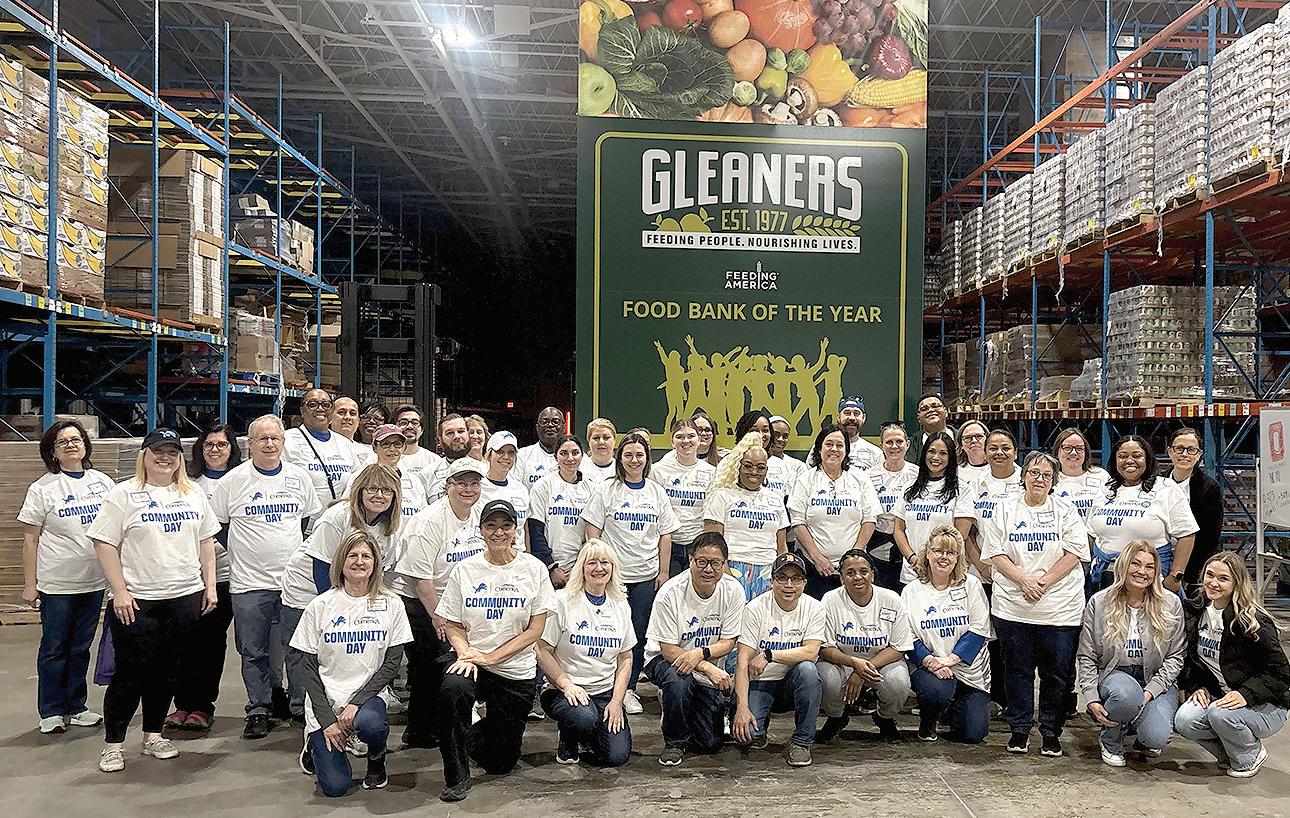
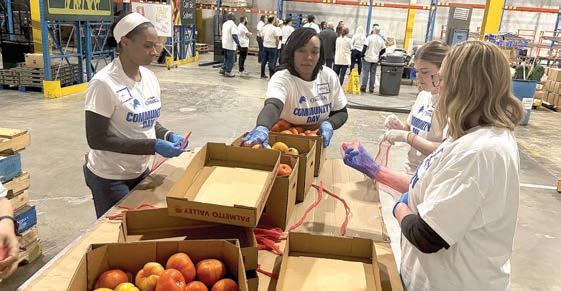

On April 17, approximately 40 Comerica Cares volunteers gathered to support Gleaners Community Food Bank. Comerica teamed up with the Detroit Lions to assist Gleaners Distribution Center in Taylor.
Gleaners’ distribution centers process a tremendous volume of donated and purchased food to serve neighbors in need.
In a partnership that has existed for over a decade, volunteers sorted and packed food items for distribution. Approximately half of the volunteers packed bags of tomatoes for distribution, while another volunteer group formed an assembly line to compile meal kits. This involved assembling cardboard boxes, loading items into boxes, stocking shelves for food loaders, lifting boxes onto pallets, counting bags and boxes,
“Comerica


colleagues who live there or locations where we have different banking centers or structures. So, it is always important for us to give back to the community and to be a force for good, which is one of Comerica’s core values.
“Gleaners is a huge part of our organization, and a huge part of what we do in the Metro Detroit area.”
Comerica Cares volunteers spent time in the warehouse packing approximately 1,500 meal kits and more than 3,200 bags of tomatoes. Food items will generate approximately 19,500 meals.
“We teamed up with the Detroit Lions for this particular event as yet another initiative to give back to the community,” said Frost.
“As you know, right now, a lot of families are having a hard time. It is so vital to assist Gleaners and package up this food and for other organizations to come and take this food to
different pantries, which helps out a huge amount to all of the communities.”
Comerica volunteers packed up over 3,000 bags of tomatoes. When asked how this small gesture can go a long way, Frost noted. “Well, anything is added value. So, it doesn’t matter if it’s a tomato, if it’s a banana, if it’s an onion, if it’s you know, whatever it is, it means we’re helping to make sure that families don’t go without food. That’s awesome.”
Comerica supports Gleaners in a variety of initiatives throughout the year.
Next month, Gleaners is a community benefactor of Comerica’s 2025 Metro Detroit Shred Day, which takes place Saturday, June 14 in Farmington Hills. As part of Shred Day, Gleaners will be on site to collect non-perishable food and cash donations. Since 2013, donations received at Shred Day have helped generate over 95,000 meals.
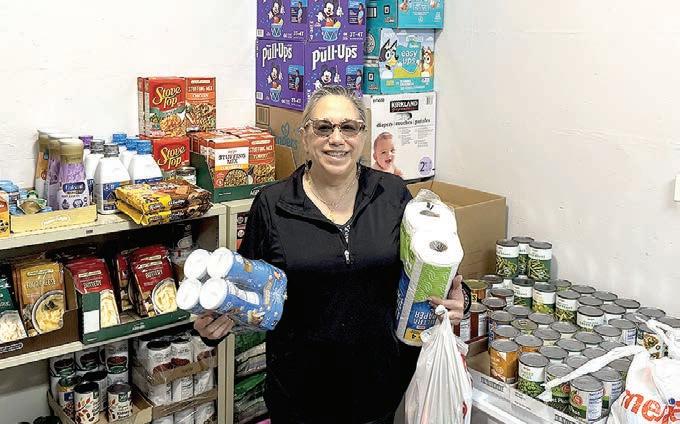
- Comerica
313
Olympia Development, Ilitch Sports + Entertainment and the City Office of Arts, Culture and Entrepreneurship (Detroit ACE) proudly presented Detroit Public Schools Community District’s (DPSCD) annual An Evening of Fine Arts for the fourth consecutive year at the Fox Theatre (56th anniversary of EFA) on Wednesday, May 14. The evening of remarkable performances by Detroit youth was free and open to the public.
Each year, when students, families and community leaders descend upon one of the country’s historic event and theater venues, the impact expands beyond how well they perform that night.
“Students’ creativity, voice, and critical thinking skills are sharpened through the arts,” said Nikolai Vitti, Superintendent, DPSCD. “As a foundation of our reform, we established an art or music program at each DPSCD school because we knew that our students’ talents would not be developed without this programming. More importantly, access to the arts allows students to define and understand beauty. This simply develops better people and citizens,” Vitti expressed his anticipation ahead of the annual showcase of Detroit’s best talent.
“As a proud alumna, I am overjoyed to once again welcome DPSCD students, educators, and leadership for an evening of spectacular performances that showcase the students’ incredible talent and dedication,” said Rian English Barnhill, Vice President of Government and Community Affairs at Olympia Development of Michigan. “It is an honor to celebrate the next generation of musicians, vocalists and dancers as they shine on this historically significant stage.”
For Comerica Bank, Evening of the Fine Arts helps elevate and spotlight the incredible talent that exists among Detroit’s high school and middle school students.
“Every year we are amazed and entertained by the talented performers who display their great passion for performance and fine arts even at their young ages,” said Steve Davis, Comerica Bank Michigan Market President. “The students who participate in An Evening of Fine Arts illustrate the many bright futures that lie ahead who will positively impact our community. We are honored to partner in supporting this annual signature event dedicated to presenting the very best of Detroit.”

“Once again, we are excited to return to The Fox Theatre with An Evening of Fine Arts strengthening its rich legacy. It continues to be encouraging to see business partners and organizations embrace our whole child commitment to our students and families.
“DPSCD has served as the pipeline for so many talented performers through the decades. Events such as this allow us to see our students’ talents annually on one of Detroit’s largest and most historic stages.”
An Evening of Fine Arts is the culminating activity for middle and high school fine and performing arts departments and showcases the tremendous talent within the district. After a competitive audition process held in March, over 600 students shined in the Fox Theatre spotlight.
The memorable evening brought all-new performances and featured instrumental music ensembles, vocal music ensembles, dance and theatre excerpts. In addition to the stage performances, original works of art by the district’s top visual artists were displayed in the Fox Theatre’s Grand Lobby.
Ilitch Companies and 313 Presents have supported Detroit Public Schools students over the years and An Evening of Fine Arts is a natural extension of that partnership, which has included financial and in-kind donations, internships and educational programs.
313 Presents is a premier live entertainment company which promotes and produces concerts, theatrical productions, sporting events and family shows at six world-class venues across southeast Michigan, including the Fox Theatre. Evening of the Fine Arts remains one of 313 Presents most unique traditions, as the company looks forward to celebrating amazing students each year.
“313 Presents is proud to continue its commitment to DPSCD’s An Evening of Fine Arts,” said Howard Handler, 313 Presents President. “This oneof-a-kind event has become a tradition at the Fox Theatre. Each year brings fresh talent and an exciting new show.”
In addition to corporate partners, the City of Detroit also supports this initiative to raise the visibility of the best of what Detroit youth have to offer.
“Watching the brilliance and excellence of our children as the best of them show their gifts should inspire the entire city to support the arts,” said Rochelle Riley, the City of Detroit’s Director of Arts and Culture. “As advocates across the region and the country unite to better support the creative workforce, we must recognize that our future creative careerists are these bright youngsters who take our breath away! So proud to support.”
For more information about An Evening of Fine Arts, visit Detroitk12.org. Follow the district on Facebook at Detroit Public Schools Community District, Twitter at @ Detroitk12, and Instagram at @Detroitk12.
the outpouring response to the flooding, SBDA reached capacity constraints, and LA SED was ready and available to utilize the resources donated through Comerica’s community needs drive.
Comerica’s support of LA SED and Southwest Detroit comes at a pivotal time for the organization as the community still feels the affects of the February flooding that devastated several neighborhoods.
It also exemplified the heart and soul of LA SED’s mission.
“LA SED’s work goes far beyond single acts of support for individuals and families,” said Farmer, “It provides relief, opens doors, creates connection, restores hope, and enables people to achieve their potential.
“This is how LA SED is helping pave the way for a bright future for the City of Detroit and its residents.”

By Ebony JJ Curry SENIOR REPORTER
The Coleman A. Young Recreation Center has always been more than a building. It has stood as a reflection of Detroit’s pride, its promise, and its power. On Saturday, May 10, that promise returned to full form as the center reopened its doors after undergoing an $11 million renovation, restoring a vital anchor in the District 5 community that had remained closed since March 2020.
The building, first opened in 1980 and named after the city’s first Black mayor, Coleman A. Young, holds weight in every corner of Detroit’s East Side. That name, etched into Detroit’s history and carried forward through generations, now finds itself at the center of a community revival. The center’s closure during the COVID-19 pandemic turned it into a testing site—another shift in purpose as Detroit navigated the uncertainties of public health and survival. However, for the residents who used its gym floors, swim lanes, and meeting rooms, the absence was never forgotten.
“Residents have been very vocal about wanting to have the Coleman A. Young Recreation Center back since we put it to use as a COVID testing site five years ago,” said Mayor Mike Duggan. “It’s taken some time, but I’m sure residents will agree, when they see the beautiful improvements that it was worth the wait.”
The wait has delivered a transformation rooted in in-
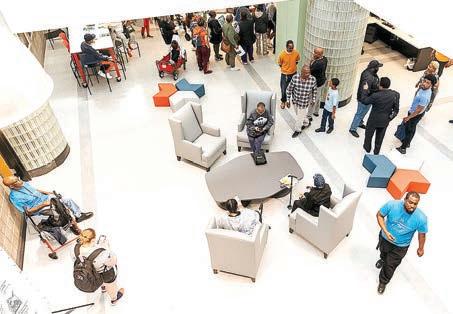
tention. Renovations were made possible through $5.9 million from the American Rescue Plan Act (ARPA) and $5.1 million from the city’s Unlimited Tax General Obligation (UTGO) bonds. These funds supported a broad and thorough renovation that combined foundational infrastructure repairs with long-overdue modern updates.
Parking lot repairs came first. Next were electric vehicle charging stations, new exterior windows, a redesigned entrance, refinished gym floors, and a new elevator. The pool’s systems were overhauled, the boiler was replaced, and both HVAC and electrical systems were upgraded. Additional fire alarm systems and CCTV surveillance enhancements were added to strengthen safety and accessibility throughout the building.
The City of Detroit’s Construction and Demolition Department brought in Gandol Inc. to execute the twophase renovation. This project was part of a larger citywide commitment to bring recreation centers back online after the pandemic left many shuttered. With Coleman A. Young has now reopened, and Detroit can count 13 recreation centers fully back in service.
For Detroiters who remember what this center once was, the reopening brings a sense of return, but it also carries a new layer of expectation. Coleman A. Young II, son of the former mayor and current Detroit City Councilman, offered words of reflection and recognition.
“I am so impressed with the attention to detail and the commitment to excellence that is shown in the construction of this building that bears the name of my father, Coleman A. Young,” he said. “This is a phenomenal structure that is filled with the spirit of my father and most importantly, the spirit of the people of Detroit.”
This spirit was felt throughout the grand reopening. More than 300 residents purchased Detroit Recreation memberships during the event, signaling more than interest. It was a community affirming its investment in
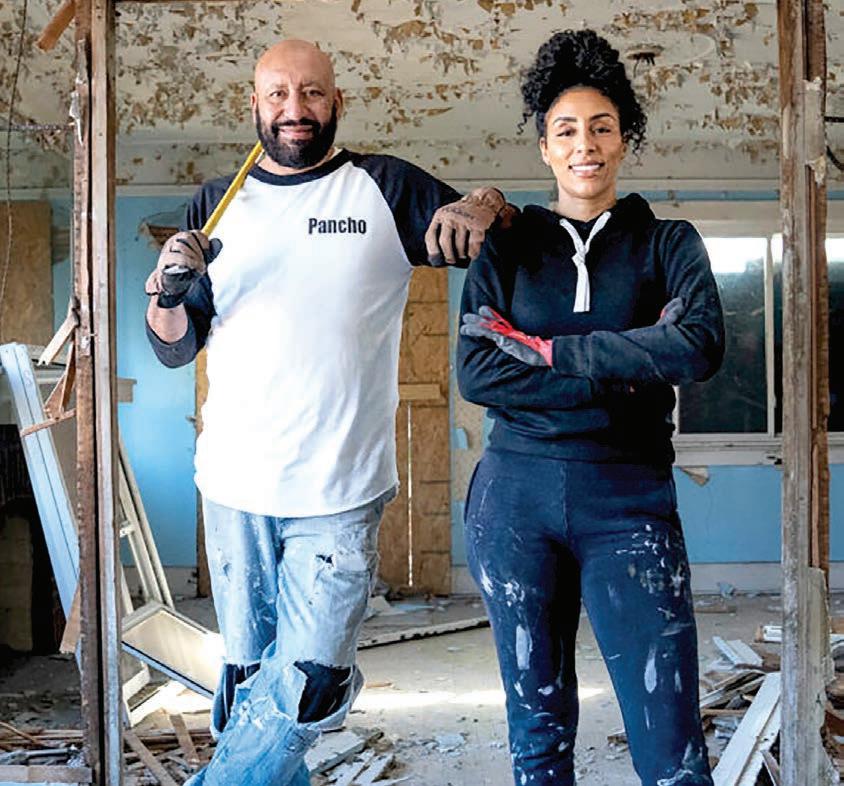




By Amber Ogden STAFF WRITER
This summer, HGTV is trading polished countertops and pristine curb appeal for boarded-up windows, sagging floors, and houses on the brink of collapse. The network’s new renovation series, Condemned, set to premiere in July, brings audiences deep into the heart of Detroit’s most daunting home rehabilitation projects, and at the center of the chaos is a local father-daughter duo determined to turn ruins into residences.
Across eight hour-long episodes, Condemned follows Pancho and Kristyn Patterson, a seasoned contractor and his design-savvy daughter, as they tackle properties that most renovators wouldn’t touch with a ten-foot crowbar. The series focuses exclusively on homes deemed “uninhabitable” by city inspectors, places that have been left to decay for years, some-
times decades, and now sit as empty husks in once-vibrant neighborhoods.
But for the Pattersons, these houses aren’t lost causes; they’re blank canvases. Each episode documents the journey of identifying a condemned home, assessing its challenges, and launching into a full-scale transformation. With roots in Detroit and deep ties to its communities, the Pattersons bring more than just tools to each job site; they bring a mission: to breathe life back into the city one house at a time.
Rather than showcasing luxury upgrades or budget-friendly makeovers, Condemned focuses on real, hard-earned restoration. Viewers can expect to see deteriorating roofs, crumbling foundations, mold infestations, and the kind of surprises that only emerge once the walls start coming down. It’s not uncommon for the team to uncover everything from outdated wiring to raccoon nests as they dig into each project.
By Amber Ogden STAFF WRITER
The Detroit skyline has long cast its shadow over hallowed courts, from the hardwood at Cobo Arena to the Palace of Auburn Hills. It’s a city where basketball isn’t just played, it’s lived. And now, that basketball heartbeat might soon pulse even stronger with the return of a WNBA franchise. At the 2025 Mackinac Policy Conference, the buzz won’t be just about policy or politics; it will be about passion. On a Thursday afternoon, attendees will pack the Grand Hotel’s theater for a dynamic panel titled Detroit’s WNBA Story, showcasing the bold bid to bring professional women’s basketball back to the Motor City. The panel will be moderated by Suzanne Shank, President and CEO of Siebert Williams Shank & Co., and will bring together a powerful cross-section of leadership behind Detroit’s WNBA expansion
Sitting shoulder to shoulder will be the Pistons Sports & Entertainment Vice Chairman Arn Tellem, legendary hooper and USA Basketball executive Swin Cash-Canal, NBA Hall of Famer and investor Grant Hill, corporate

Shock reigned as one
leader Sandy Pierce, and the visionary duo behind it all, Pistons owner Tom Gores and his wife, Holly Gores. Together, they will paint a picture of a franchise and a full-scale cultural and economic revival.
Detroit’s WNBA story is not new; it’s a comeback. From 1998 to 2009, the Detroit
Deanna
Over nine seasons with the Shock, she played a pivotal role in securing three WNBA championships (2003, 2006, 2008). Her outstanding performance in the 2006 Finals earned her the Finals MVP award. Nolan’s career statistics are a testament to her impact: she averaged 13.6 points, 3.8
That same passion for basketball remains strong across the city. Fans remember the Shock era and have long hoped for its return. The foundations built during that time are still visible in youth programs and fan communities, and the legacy of Detroit-born players continues to thrive.
In January 2025, Tom and Holly Gores officially submitted a bid for a WNBA expansion franchise, uniting leaders across business, sports, and entertainment. It marks one of the most significant collaborative efforts in Detroit sports history, focused on making professional women’s basketball a permanent and deeply rooted part of the city.
The vision for this team extends beyond the game. It’s designed to uplift the entire community, offering pathways for youth, economic mobility, and representation at every level of sport and business.
The bid is backed by infrastructure support from the Pistons organization, including access to Little Caesars Arena, existing sports marketing expertise, and established community programs. The franchise is also positioned as a growth engine for downtown development, job creation, and civic pride.
This moment in sports is uniquely poised for the rise of women’s professional leagues. The WNBA has seen record-breaking viewership, increased sponsorship, and a generational influx of talent following the highly publicized 2024 draft class. Cities are now recognizing that women’s sports deliver both cultural and commercial value.
Detroit’s bid aligns perfectly with this momentum. With a strong sports culture, an energized fan base, and corporate leaders stepping up, the city stands as a model for how to launch a women’s franchise with both purpose and profitability.
Few markets can match Detroit’s mix of history, heart, and hunger for basketball. The timing could not be better for reintroducing a WNBA presence.
What distinguishes this bid is its commitment to lasting social and economic impact. Plans are already in motion to tie the team into youth development pipelines, education programs, and professional leadership opportunities for women in sports and beyond.
The team would serve as more than entertainment; it would be a catalyst for change. It aims to inspire young women to see themselves in all roles of the sports ecosystem, from players and coaches to executives and entrepreneurs.
The presence of leaders like Sandy Pierce on the panel highlights the focus on integrating this initiative with broader community and workforce development strategies. The bid doesn’t just ask what a team can do for Detroit, it asks what Detroit can build together through a team.
Though full approval from the WNBA is still pending, Detroit’s bid is widely viewed as one of the most compelling and community-oriented proposals under review. League officials are expected to make decisions on expansion later in 2025, with potential franchise launches as early as the 2026 season.
If successful, it would mark the return of WNBA basketball to Detroit nearly two decades after the Shock’s final title run, reviving a chapter of sports history that fans have never forgotten.
This initiative signals more than a franchise revival; it’s a reawakening of spirit, a convergence of legacy and leadership, and a vision that sees sports not just as entertainment but as a force for economic growth, gender equity, and civic pride.
For Detroit, the story of a new WNBA team is about far more than basketball. It’s about reclaiming a space in the national conversation, inspiring future generations, and building a foundation where everyone can belong.
This time, it’s not just about bringing a team back. It’s about building a movement that reflects Detroit’s strength, resilience, and ambition.
The series sets itself apart from traditional renovation shows by embracing the grit and history of the properties it features. Each home has its own story, of abandonment, economic downturn, and sometimes loss, and Condemned doesn’t shy away from the emotional and physical toll that such projects demand. The Pattersons face relentless challenges: unexpected structural issues, bureaucratic red tape, tight budgets, and the pressure of bringing livable space back to struggling communities.
Detroit, long known for its industrial might and cultural impact, has also become symbolic of urban decline and the slow road to recovery.
In recent years, however, a wave of local efforts has sought to preserve what remains rather than erase it, and Condemned taps directly into that movement. By focusing on restoration instead of demolition, the show emphasizes sustainability, heritage, and the
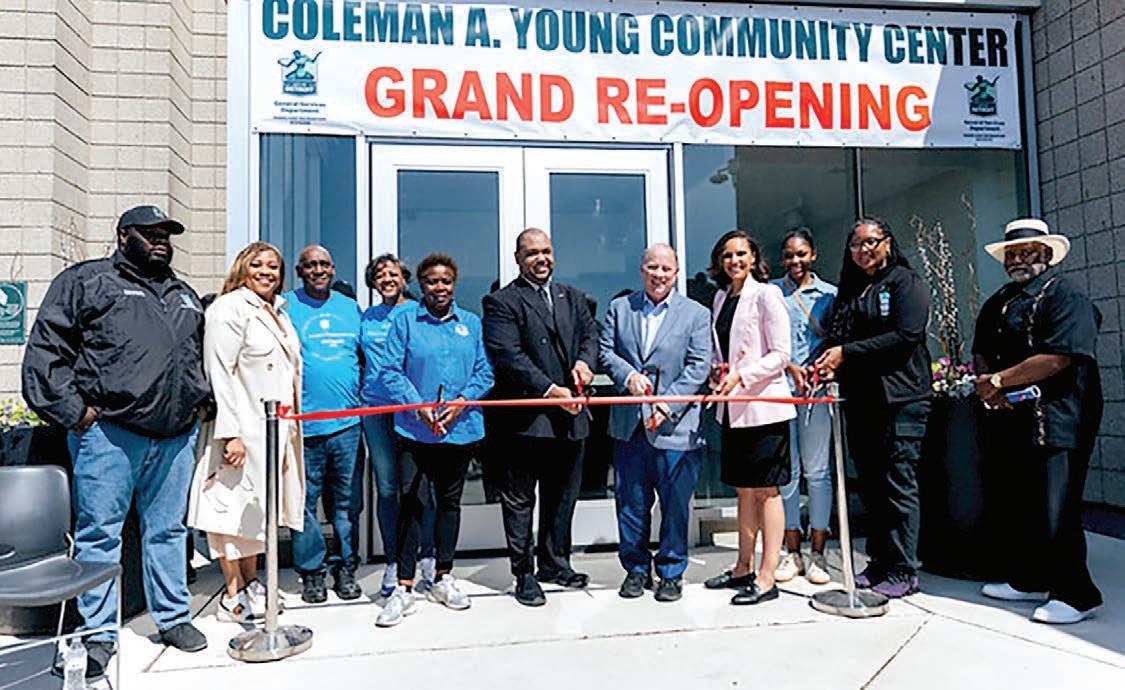
shared spaces, generational access, and collective healing.
Crystal Perkins, General Services Director, emphasized the significance of what the center means for community development and continuity.
“The reopening of the Coleman Recreation Center is more than a return—it’s a renewal of our commitment to community, connection, and opportunity,” Perkins said. “This space has long been a cornerstone for generations, and today, it reopens its doors with new energy and purpose. May it continue to be a place where memories are made, futures are shaped, and our community grows stronger together.”
Inside the building, new furniture has been added to meet modern standards of comfort and accessibility. A brand-new e-sports lounge stands ready for a generation of young gamers looking for space to connect and compete. Fitness equipment in the weight room has been upgraded, and new gaming equipment offers additional programming potential.
What makes this moment notable isn’t just the return of services but the way the city has chosen to reinvest in its neighborhoods. Council President Mary Sheffield spoke directly to this in her remarks during the reopening celebration.
“The reopening of the Coleman A. Young Recreation Center is more than a celebration of a building, it’s a celebration of community, opportunity, and progress,” Sheffield said. “This $11 million dollar transformation brings new life to a space that has long been a cornerstone for youth, families, and seniors in our city. I’m proud to stand with residents as we reopen this vital center and renew our focus on neighborhood investment and access to quality public spaces.”
Drop-in programming officially begins Monday, May 12. Scheduled programming is set to begin on May 19. The timing aligns with the city’s efforts to provide summer options for youth and family engagement as schools begin to wind down.
This opening not only signals completion of the recreation center restorations that were delayed due to COVID-19—it underscores Detroit’s broader strategy to use public funds to rebuild community spaces that hold cultural and social weight. These centers serve as safe spaces for children after school, workout destinations for elders, gathering places for family reunions, and critical access points for city services.
Work continues across the city. Construction is still underway at the Helen Moore Community Center, formerly known as Dexter-Elmhurst Recreation Center. Its completion will mark another milestone in Detroit’s mission to restore and reintroduce trusted places where community development is not just promised but practiced.
Recreation centers do not make head-
importance of revitalizing neighborhoods without displacing their original character.
While the show is heavy on demolition, sweat equity, and problem-solving, it also finds space for levity and heart. Much of the show’s appeal lies in the dynamic between Pancho and Kristyn. With decades of experience under his belt, Pancho brings practical know-how and a deep love for the city. Kristyn, with a fresh perspective and a keen eye for design, balances out the team with creative solutions and a modern vision for livable, functional spaces.
Their back-and-forth offers a human touch to the high-stakes world of home rehabs, grounding the show in real relationships and generational knowledge. The father-daughter partnership is one of the many aspects that give Condemned its unique charm, as viewers watch the pair navigate not only construction hurdles but also the dynamics of working as a family.
Each finished project reveals more than just a new kitchen or refinished floors;
it uncovers the hidden potential within homes that many had written off. The transformations are dramatic, not just in aesthetics but in impact. Restored homes are put back into the hands of Detroiters, helping stabilize neighborhoods and combat blight, one address at a time.
HGTV’s decision to launch Condemned in Detroit is a nod to the city’s complex narrative of resilience and reinvention. Unlike shows that highlight dream homes in already-thriving markets, Condemned goes where few others do, into the heart of a city that has weathered economic storms and emerged with a stubborn determination to rebuild.
Premiering this July, Condemned offers more than just a renovation spectacle. It delivers a raw, unfiltered look at what it takes to bring homes and communities back from the brink. For viewers tired of pristine paint swatches and drama-free redesigns, this series promises something real: the power of transformation in the places that need it most.

lines the way stadiums or skyscrapers do.
Yet they shape lives quietly and powerfully. They are where friendships are formed, scholarships are sparked, and young people gain structure and self-worth. For Detroit’s Black community, spaces like Coleman A. Young Rec Center has long provided sanctuary and strength.
This reopening didn’t happen overnight. It took vision, dollars, political will, and the voices of residents who refused to let the space be forgotten. The dollars that flowed into this renovation, particularly from ARPA, represent federal funds finally working at the neighborhood level, with results that can be felt and used by those who have waited the longest.
Coleman A. Young, the man, never backed down from the fight for equity, especially in the neighborhoods that main-


stream
The restored building doesn’t need to speak for itself. The people walking through its doors—some for the first time, others returning after years—are carrying the message forward. Detroiters know what this means. They always have.



By Ebony JJ Curry SENIOR REPORTER
Tarsha Gale grew up knowing titles didn’t fix systems. Action did. Her career, shaped by service, not spectacle, has always been rooted in that truth. Now, as the newly appointed Executive Director of Brilliant Detroit, she’s stepping into a role that demands both vision and grit. And she’s coming with both.
Brilliant Detroit announced the leadership transition with purpose. This isn’t just a new chapter for an organization. This is a call to remain grounded in community while building with scale. Gale’s name is not new in Michigan’s nonprofit and human services landscape. She’s led from the front and stood in the trenches, especially for children and families who’ve been locked out of opportunity.
Her most recent role as Executive Branch Director of Bethany Christian Services – Southeast Michigan stretched across counties, managing growth in foster care, adoption, and family preservation. Under her direction, the organization secured new funding, strengthened partnerships, and expanded its reach, without compromising integrity. That kind of leadership doesn’t get taught in textbooks. It’s built by listening closely, moving intentionally, and putting community first.

“Tarsha possesses a wealth of experience in leading programs and strategic initiatives that address systemic barriers and create pathways to success that make her a true asset to the Brilliant Detroit team and the families we serve,” said Cindy Eggleton, Co-Founder and current CEO. “She has a deep passion for Brilliant Detroit’s mission, which reflects her central values of equity, inclusion, and a deep belief in the potential of every child and family.” Gale is credentialed, no doubt. She holds two master’s degrees from Wayne State University—one in counseling psychology, the other in human development—plus a Certificate in Infant Mental Health. But it’s her lived experience, navigating systems and pushing against bureaucratic walls, that sets her apart. From her days as a psychotherapist to her work as a Licensing Certification Specialist for the State of Michigan, Gale has always focused on where policy meets people. Her leadership comes from the classroom, the clinic, and the community, not a boardroom bubble.
Brilliant Detroit is not your average nonprofit. It was never built to be. Since its founding in 2016, the mission has been clear: create kid-success neighborhoods where children from birth through age eight are school-ready, healthy, and surrounded by support. That mission is now reaching over 26,000 children and caregivers across 24 neighborhoods in the city. Real work. Tangible results. No press-only presence.
Michael R. Tyson, Chair of the Board of Trustees for Brilliant Detroit, captured the moment clearly. “Brilliant Detroit is inheriting the reins of an organization that seeks to reject business as usual and strive for transformative change in communities, all with, for, and by our neighbors.”
That’s the foundation Gale walks into. One built by Detroiters, for Detroiters. The kind of space where neighbors don’t just show up for programming—they co-create it. Gale’s appointment means continuing that legacy with new momentum, not reinventing the mission.
Cindy Eggleton, the architect behind Brilliant Detroit’s bold blueprint, will not be fading out. Instead, she will fully transition to lead Brilliant Cities, a national expansion initiative launched last year. It’s designed to take Detroit’s model to cities across the country, starting with Philadelphia.
“Brilliant Detroit has been a dream that we have watched become a reality and it has been the most purposeful work of my life,” Eggleton said. That sentiment is shared by many in Detroit who’ve seen what happens when neighborhoods are given the keys to design their own solutions. This transition doesn’t end that work—it strengthens it.
Brilliant Cities, led by Eggleton, aims to replicate Detroit’s grassroots-rooted model without copying it. The idea is not to duplicate Detroit’s neighborhoods. It’s to honor the methodology—engage communities directly, make decisions alongside them, and center early childhood well-being in every move. As this model scales nationally, Detroit’s leadership will remain at its core.
Gale will not lead alone. She’ll continue to work closely with Eggleton as the local and national arms of Brilliant evolve side-by-side. But make no mistake—Gale’s voice, leadership, and lens will shape the organization’s future here in Detroit.
Her track record shows she understands the complexities of Black motherhood, early childhood care, mental health, and family infrastructure. And not from afar. She has lived, worked, and served across Michigan systems that too often fail families of color. Her expertise is backed by receipts—not rhetoric.
This transition also brings new urgency. As Detroit navigates shifting policies around education, childcare access, and economic equity, organizations like Brilliant Detroit become even more critical. They’re not just offering programs. They’re creating protective environments where kids can grow up whole.
From the outside, this moment may look like a leadership swap. From the inside, it’s a testament to how institutions rooted in community must evolve: by lifting leaders who are deeply connected, unapologetically experienced, and clear on what matters most. Gale checks all those boxes.
Families who’ve benefited from Brilliant Detroit’s model already know what’s possible. Now the goal is to go deeper, not broader, for the sake of headlines. As more neighborhoods express interest in joining the network, Gale’s leadership will shape how that growth happens with care and fidelity.
Eggleton and Gale are both aligned on that. The mission doesn’t shift with titles. The model doesn’t get diluted because it’s going national. Detroit remains the heartbeat of this work, and its people remain the architects.
Brilliant Detroit has always been a disruptor. Not by flash, but by commitment. Not by shouting vision, but by living values. And now, as the organization steps into this next phase, it’s clear that the brilliance is still right here— growing, glowing, and held in the hands of a Black woman who’s already been doing the work.
This isn’t about symbolism. This is about stewardship.
Gale’s name might be new to some, but her work has always been centered in service. For Detroiters watching what happens next, it’s not about whether she can lead— it’s about how far she’ll take it, with community right beside her.
And as Brilliant Cities prepares to rise, Detroit’s story remains the blueprint. Our model. Our brilliance. And now, our moment is led by a woman who has earned every step.



Detroit-based gospel ensemble delivers powerful messages of faith, unity, and worship with original music and star-studded collaborations.
In a moment years in the making, Bishop Charles H. Ellis III and the Greater Grace Worship Choir have released their highly anticipated debut album, a powerful nine-track project that blends traditional gospel roots with a contemporary sound sure to resonate with worshippers of all generations.
The self-titled album, available now on all major streaming and download platforms, features standout singles “Favor,” “Done For Me,” and “Best Praise.” It also brings together an impressive roster of guest gospel luminaries, including Jonathan Nelson, Paul Porter, Chrystal Rucker, Lillian Lloyd, and Greater Grace Temple’s own Felena Canty.
“I am beyond excited that our complete 9-song album is available and affordable for all gospel music lovers on most music platforms,” said Bishop Ellis, senior pastor of Greater Grace Temple. “Our Worship Choir expresses the anointing of God through their talents along with many established gospel artists who have been friends of our ministry down through the years.”
From the very first note, the album delivers what its creators describe as “a spirit-filled collection of original gospel songs for worship and everyday encouragement.” Each track stands as a testament to the power of faith and the enduring relevance of gospel music in both sacred and secular spaces.
Behind the project is a collaboration between co-producers Justin A. Brooks (J Brooks) and Deerico Loyd also serve as the director of music ministry at Greater Grace Temple. Loyd takes the lead on “Favor,” a vibrant track that has quickly become a favorite in worship circles.
“This project has been in the works for some time and is truly a labor of love,” Loyd said. “Every track speaks to the heart of worship and the sound of our ministry. It’s both traditional and fresh, providing something for every generation of worshippers.”
The album marks the debut release from Graceful Records, Greater Grace Temple’s in-house label launched in 2023. It’s a bold new venture for the historic Detroit church, expanding its already significant spiritual and cultural footprint into the realm of recorded music.
“Graceful Records is honored for the opportunity to have Bishop Charles Ellis and the Greater Grace Worship Choir be the first project release on our label,” said Walter Kearney, president of the label. “It has songs that choirs and praise teams can sing every Sunday. Supported by quality production, we believe that the project has amazing songs that will truly be a blessing to the masses.”
Founded in 1927, Greater Grace Temple is one of Detroit’s most prominent churches, boasting over 6,000 members and a sprawling 20-acre campus known as the City of David. The church has long been a cornerstone of community outreach and spiritual empowerment, and now, through music, it is expanding its mission to uplift and inspire on an even broader scale.
The debut album reflects this mission, weaving together messages of hope, gratitude, and divine favor. Whether it’s the soaring vocals of Chrystal Rucker, the soulful delivery of Paul Porter, or the rousing harmonies of the Worship Choir, each contribution adds to the richness of the album’s sound and spirit.
Bishop Ellis, a dynamic preacher and community leader known for his charisma and vision, sees the project as more than just music—it’s ministry.
“We want people to be blessed, encouraged, and reminded that God is with them every step of the way,” he said. “This album is an extension of the pulpit—a way to minister through melody, harmony, and praise.”
With future projects already in the pipeline for Graceful Records, this debut sets a high standard and offers a promising glimpse into what’s to come from the label and the Greater Grace music ministry.
“This is just the beginning,” Loyd added. “We’re excited about where God is taking us musically and spiritually. There’s more to come.”
The album, Bishop Charles H. Ellis III and the Greater Grace Worship Choir, is available now on Apple Music, Spotify, Amazon Music, and other major platforms.

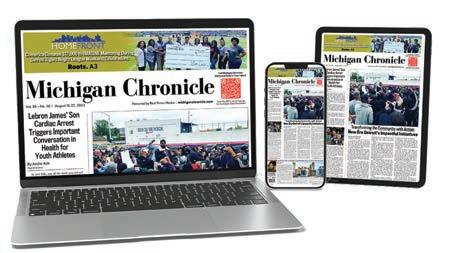

By Ebony JJ Curry SENIOR REPORTER
Ten weeks into a pregnancy, a woman already navigates new terrain—doctor visits, morning sickness, shifting hormones, shifting priorities. Under a new Michigan proposal, that shift could also mean a tax break. A bill introduced by State Representative Gina Johnsen would allow expectant parents to claim a fetus as a dependent on their state taxes. That means if someone is ten weeks pregnant by year’s end and a doctor signs off, Michigan could consider that fetus a person for the purposes of personal exemptions.
The bill is being heard before the House Finance Committee and is stirring discussion that runs deeper than tax codes. It presses on economic realities, reproductive rights, and the lived experiences of Black families who have long fought to be seen, heard, and supported at every stage of life, from conception to birth to adulthood.

Johnsen, a Republican from Lake Orion, said her intention is rooted in the cost of parenting starting earlier than people often calculate. “Everything costs more to just survive, raise a family, take care of yourself. But, even starting at pregnancy, the costs go up,” she said. “And this bill is to recognize that that’s when the costs start, not just when a child is born.” Under current Michigan tax law, each dependent adds a personal exemption that adjusts yearly. For 2024, that amount is $5,600 per person or dependent. The proposal could mean modest savings for families anticipating a birth, but that figure barely touches the realities many parents, especially Black mothers, face in a system that often treats their needs as an afterthought.
Danielle Atkinson, founder of Mothering Justice, is clear about what this bill doesn’t address. She questions the impact of the exemption and points to the larger structural gaps. “If this was in good faith, we would definitely be looking at the true cost of care, money that’s lost when you are out of work,” she said. “And just overall what it takes to raise a child in this society.”
The national average to raise an infant, according to Atkinson, now tops $14,000 per year. That includes childcare, formula, food, diapers, clothes, and healthcare, not to mention the income lost when a parent, most often a mother, takes time off work to recover from birth or care for a sick child. A one-time tax deduction barely scratches the surface.
The broader implications stretch beyond economics. This kind of legislation comes after the U.S. Supreme Court struck down Roe v. Wade, unraveling decades of federal abortion protections. Georgia was the first state to pass a similar fetal tax exemption, one that directly connected to its fetal heartbeat law. Michigan’s bill doesn’t include such a clause, but reproductive rights advocates are not ignoring the timing.
That nuance matters in communities already fighting for autonomy over their bodies and their families. Black women in Michigan, like across the nation, experience higher rates of maternal mortality, are more likely to be denied medical care, and face disproportionate economic hurdles that no line item on a tax form will fix.
Johnsen said her proposal mirrors the federal WIC program, which already considers pregnant people eligible for food assistance. “I just want the moms to have an opportunity to have some assistance here and recognize that this is financially more difficult than not having a baby,” she explained. But even WIC—a deeply critical program—functions as a supplement. It doesn’t resolve wage gaps, employment discrimination, housing instability, or inequitable access to healthcare.
To Atkinson and other community advocates, the problem isn’t whether pregnant people need more financial support. They do. The question is whether this bill is the best pathway. Atkinson pointed instead to initiatives like Rx Kids, a program that gives monthly checks directly to new mothers and babies during their first year of life. That kind of model, she argued, shows what’s possible when the goal is sustained support rather than symbolic policy.
“We have to think in the totality of when we’re talking about moms and families and babies, what does the most good,” she said. “And we need to put our attention and our resources behind those initiatives.”
The debate lands in a state budget season marked by deep divides. House Republicans have made clear their priorities: slashing income taxes across the board, diverting funds to infrastructure, and cutting back what they call wasteful spending. Democrats, on the other hand, have warned that such broad cuts threaten public services and Michigan’s already thin social safety net.
There’s also a competing proposal from Senate Democrats calling for a “working parents tax credit,” which they argue would provide more tangible help to families, especially those raising children on low to moderate incomes. That approach could support parents already juggling bills, work, and caretaking without needing to define a fetus as a dependent to access help.
Johnsen defended her bill as part of a moral duty. “We say we’re looking out for the most vulnerable. Well, the most vulnerability are the babies and the pregnant moms and the elderly and the veterans. They have to come first. Or we don’t have a thriving and strong society,” she said.
But that framing raises another layer of concern—one echoed across historically underfunded and overpoliced Black communities. The language of “protecting the vulnerable” has often been weaponized to restrict reproductive freedoms or gut public benefits under the guise of morality. For Black parents in Michigan, true investment means more than rhetoric. It means reliable access to healthcare, maternal leave, equitable pay, community-centered prenatal support, and safe neighborhoods.
The stakes in this conversation are not theoretical. Detroit remains one of the poorest major cities in the country, where Black families are disproportionately impacted by maternal health disparities, food deserts, housing displacement, and the kind of systemic neglect that no tax exemption can paper over. Programs like Mothering Justice, Black Mothers’ Breastfeeding Association, and Detroit Mama Hub do the ground-level work that the state too often sidesteps.
This moment, then, is not only about what counts as a dependent. It’s about whether policy in Michigan will reflect the lived truths of the people most affected. Will it center those who have been undercounted, under-resourced, and underserved for generations? Or will it continue to prioritize political points over people?
Johnsen expects a vote on her bill in the House in the coming weeks. As that hearing approaches, communities across the state—especially Black-led organizations and advocacy groups— are watching closely, not just for the outcome, but for what it reveals about whose lives are being counted.
Because when the ink dries on policy, it’s not lawmakers who live with the consequences. It’s the mother choosing between rent and formula. It’s the family stretched too thin. It’s the neighborhoods building support networks with or without state assistance.
The conversation shouldn’t end with a tax form. It should start with a mirror to our values—and who gets seen in the reflection.

By Amber Ogden STAFF WRITER
As of 2023, the homeownership rate among Black residents in Detroit stands at approximately 49.7%, compared to 57.9% for white residents, highlighting a persistent racial gap in homeownership within the city. This disparity is even more pronounced when considering that Black residents constitute about 77% of Detroit’s population.
Initiatives such as Detroit’s Downpayment Assistance Program (DPA), launched in 2023, have demonstrated success in promoting Black homeownership. The program provided up to $25,000 in assistance and facilitated home purchases for over 300 Detroit residents, with 93% of recipients being African American.
Despite these efforts, challenges remain. Black applicants in Detroit are still denied home purchase loans at twice the rate of white applicants. Moreover, homes owned by Black individuals in Metro Detroit are typically valued nearly 45% less than those owned by white individuals, further exacerbating the wealth gap.
Belong Lending’s mission to provide transparent, people-first mortgage services is a step toward addressing these systemic issues. Their commitment to community empowerment and financial education aims to make homeownership more accessible and equitable for Black Detroiters, fostering long-term wealth-building opportunities.
Belong Lending, a purpose-driven mortgage lending firm founded by three Detroit financial professionals, will host its official grand opening celebration on Saturday, May 31, 2025, from 2:00 PM to 5:00 PM at 7436 Woodward Ave, Suite 205 in Detroit. The event is free and open to the public and will feature a ribbon-cutting ceremony with Detroit City Council President Mary Sheffield, live music from a DJ, a food truck, and raffle prizes donated by local businesses and community partners.
As housing access and affordability continue to challenge Detroiters, Belong Lending is carving out a new lending model that puts people first, not just paperwork. Founded by professionals with deep roots in the community, the firm blends financial expertise with cultural understanding, helping clients feel empowered and informed. The opening of the new office location is a public affirmation of the team’s values: transparency, education, trust, and belonging.
Belong Lending is a Detroit-based mortgage lending firm committed to helping people navigate the homebuying process with confidence, clarity, and care. Co-founded by Jalen Scott, Antoinette Gassaway, and Demetris Holloway, the firm offers lending solutions with a people-first mindset and has served hundreds of families across Michigan and beyond. Their mission is to provide clients with the knowledge and support needed to build long-term wealth, starting with a home.
Jalen Scott, Co-Founder of Belong Lending, highlighted that this isn’t just another office opening but a
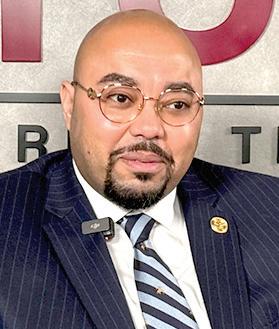



statement of what he and his team believe is possible when Detroiters have access to tools, education, and people who truly care.
“We wanted to build something that honors where we come from and helps move the needle for first-time buyers, working families, and anyone who’s ever felt left out of the mortgage process,” Scott said.
“Belong is about giving people a seat at the table — and making sure they understand the contract in front of them.”
Since its founding, Belong Lending has grown almost entirely through referrals, thanks to its responsive team, relationship-first approach, and strong local partnerships.
Antoinette Gassaway, Co-Founder, highlighted that everything about the company’s growth so far has been built on trust.
“This celebration is our way of giving that energy back to the city,” Gassaway said.
“We believe in showing up with honesty, compassion, and clarity. That’s how we’ve been able to support so many others win.”
The May 31 event will highlight those community values with festive energy and Detroit pride. Guests can enjoy music, food, and raffles, with prizes donated by Vanguard Title, Title Connect, UWM, Cameron Young, Allstate, and Malinda Mims, State Farm. It’s more than a party, it’s a thank-you to the community that has supported the firm’s vision from day one.
Looking beyond the grand opening, Belong Lending plans to expand its team, launch community-focused financial education programs, and increase lending support in under-resourced areas. The co-founders also aim to deepen partnerships with local realtors, host first-time homebuyer workshops, and invest in neighborhood revitalization projects across Detroit.
Black-owned mortgage companies like Belong Lending play a crucial role in addressing these disparities. By offering culturally competent services and understanding the unique challenges faced by Black homebuyers, these institutions can provide more equitable access to mortgage financing. This not only helps increase Black homeownership rates but also contributes to closing the racial wealth gap and fostering economic empowerment within Black communities.
Demetris Holloway, Co-Founder, talks about how the city gave him everything, and he knew he had to pour back into it.
“From mortgage lending to property flipping, I’ve worked hard to be a part of the change I want to see,” Holloway said.
“With Belong, we’re doing more than closing deals — we’re helping people build futures. That’s what this event is all about: showing up for the community that raised us, and making sure more Detroiters feel confident stepping into homeownership.”
The event is free and open to the public, and guests are encouraged to RSVP in advance at: https://shorturl. at/6m8e7







PUBLIC NOTICE OF BUDGET HEARING
PLEASE TAKE NOTICE OF THE BUDGET HEARING FOR THE BOARD OF EDUCATION OF HIGHLAND PARK SCHOOL DISTRICT
The property tax millage rate proposed to be levied to support the proposed budget will be a subject of this hearing.
DATE OF MEETING: June 10, 2025
LOCATION OF MEETING: The Board of Education Members Meet at Barber Preparatory Academy Media Center (In Person) 45 E. Buena Vista Street Highland Park, MI 48203
Public Guests Join via Zoom (Virtual Option) or In Person Join Zoom Meeting Link: https://us06web.zoom.us/j/85372668054? pwd=cffnS9SZneWD5QtgeROcT0ozLeFGI2.1
Meeting ID: 853 7266 8054 Passcode: 776945
TIME OF MEETING: 5:00 p.m.
TELEPHONE NUMBER OF THE PRINCIPAL OFFICE OF THE BOARD OF EDUCATION: 313-402-0266
THE BOARD MINUTES ARE LOCATED AND 12360 Woodward Ave
AVAILABLE FOR INSPECTION AT THE HPSD Highland Park, MI 48203
OFFICE OF THE BOARD OF EDUCATION:
PURPOSE: A Presentation of the Proposed FY26 HPSD Operating Budget. Regular Meeting to Follow at 6:00 p.m.
Yolanda Harrison Secretary, Board of Education
AMERICANS WITH DISABILITIES ACT NOTICE:
Any individual with a disability who require accommodations for participating or attending this meeting should contact the Board of Education at 313-402-0266 in advance of the meeting to request assistance.
MISSION STATEMENT: To provide a high-quality public education that assures students will receive a comprehensive learning experience which prepares them to compete in a global 21st century society.
Nanotechnology, Artificial Intelligence, and Synthetic Biology Consultant (NAIS)
Internal / External -- Full-time position – JOB ID: 7080
Reports To: K-12 Career Readiness Supervisor
Salary Range: $96,106 - $111,453 – Exempt /12-month work year
Exempt / 12-month work year
Applications will be accepted until positions are filled.
Summary of Responsibilities:
You will deliver direct services to students, staff, and districts and provide professional development, consulting services, and leadership with the K-12 Career Readiness Unit within the Student Services Department. As a Nanotech, AI, and Synthetic Biology Consultant, you will be pivotal in our innovative K-12 Nanotech, AI, and Synthetic Biology Lab. We are seeking individuals with a master’s degree or higher in Nanotechnology, Biotechnology, Bioengineering, or a closely related field. Demonstrated expertise in Nanotechnology is essential, complemented by a solid foundation in basic molecular biology and cell culture.
Experience with animal models is preferred but not mandatory. You will assist district staff and students to connect to business and industry meaningfully to help prepare all students for careers. You will carry out the county-wide plan that supports STEM-integrated content development based on real-world examples, professional development to support educators, and in-class coaching to support teachers and students in the implementation of relevant, problem-based content.
Our lab serves 28 independent local districts, providing a unique opportunity to engage with K-12 students and educators. You’ll have the chance to inspire the next generation of scientists and innovators through hands-on demonstrations, workshops, and collaborative projects.
Education: Master’s degree or higher in Nanotechnology, Biotechnology, Bioengineering or a closely related field.
Experience: Minimum of three (3) years of relevant experience in a research or educational setting. Deep understanding of educational systems, legal issues, policies, research and trends in Career Readiness.
Other:
• Relevant coursework in Nanotechnology, AI, Synthetic Biology, molecular biology, and cell culture. A valid Michigan Teacher and/or vocational endorsement is preferred.

In accordance with state and federal law, Oakland Schools does not discriminate, nor permit discrimination, on the basis of race, color, national origin, ethnicity, religion, sex, pregnancy or parental status, gender identity, gender expression, sexual orientation, disability, age, height, weight, marital status, military service, veteran status, genetic information, or any other legally protected status, in its educational programs and activities, employment, or enrollment. The District also provides equal access to the Boy Scouts and other designated youth groups. For questions or complaints regarding unlawful discrimination or harassment, employees should contact the Assistant Superintendent of Human Resources, Personnel Management and Labor Relations at (248) 209-2429 or HR@oakland.k12.mi.us. Students and others should contact the Civil Rights/Title IX Coordinator at (248) 209-2590 or Jacqueline.Zablocki@oakland.k12.mi.us.
This job posting is intended to describe the general nature and level of work being performed by a person assigned to this job. It is not to be construed as an exhaustive list of all job duties that may be performed by a person so classified. Incumbents may be asked to perform additional duties as required by his/her supervisor.
(StatePoint) Ancient civilizations had hieroglyphics, we have QR codes: the patterned graphic boxes prompting you to access restaurant menus, pay for parking, find out information about a package and more. Generally, quick response (QR) codes are safe, but they can be used to redirect you to malicious websites, so caution is important. Here’s how it works.
• You get prompted to use your device’s camera.
• You scan the code and a link pops up.
• You click the link, exposing you to threat actors.
• You’re directed to apps, websites, locations using your maps and much more.
Bad actors understand people are in a rush, so this is an appealing form of attack. It’s a cost-efficient scam because these codes are easy to generate and distribute. And they are creative in finding new ways to make them appear legitimate. In public places, criminals can cover an official code with a sticker or printout showing a fraudulent code. Some of the more prevalent and convincing scams include:
• Parking Ticket Scams. Criminals place fake parking tickets with QR codes on windshields, causing unsuspecting victims to scan the code and click the link to
Hope Academy, a public school academy, will hold its Budget Hearing on Tuesday, June 10, 2025 at 6:00 p.m. at Hope Academy, located at 12121 Broadstreet, Detroit, MI 48204. The budget will be available for inspection at Hope Academy.
The Board of Directors of WAY Academy, a public school Academy, will contact a public hearing for the proposed budget for the 2025-2026 school year on June 17th, 2025 at 5:30 PM. The meeting will be held in person at 8701 W. Vernor Detroit, MI 48209 and via zoom meeting. The link will be provided at www.wayacademy.net/detroit. This meeting is open to the public and copies of the proposed budget will be available at 397 Main St. Ste 1, Belleville, MI 48111 for the public to review during regular business hours beginning June 18, 2025.
Operations Manager
PHINIA Delphi USA LLC: We seek an Operations Manager based out of our office at 1624 Meijer Drive, Troy, MI 48084 Manage all activities related to Plant Operations and maintain effective working relationships with other departments to establish a unified approach to Production Operations; among other duties. Apply to job reference number R2025-0062 at https://phinia.wd5.myworkdayjobs.com/ PHINIA_Careers
Sr. Design Release Engineer
Yazaki North America Inc. is seeking a Sr. Design Release Engineer in Canton, MI. Responsible for defining retention and covering components to be used on the wire harness; initiate NCRs and interface with Advanced Purchasing, Advanced Supplier Development, Provisional Component Engineering, and ComBU for the development and approval of newtooled components, among other duties. Up to 30% dom/int’l travel req./yr. Apply online at: https://careers.yazaki.com/ REQ #147861.
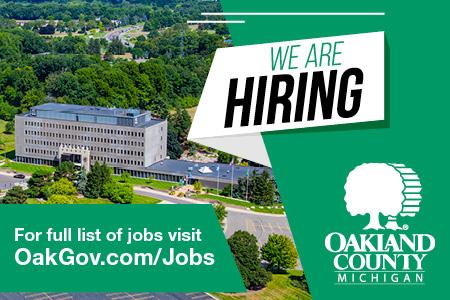

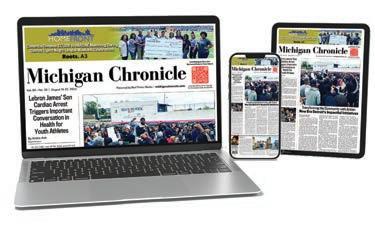

(StatePoint) Financial services offer a strong career path
particularly in the field of financial planning. Demand for financial advisors is rising, and leaders in the financial planning ecosystem are working to diversify the workforce to better serve all consumers. Here’s why CERTIFIED FINANCIAL PLANNER® professionals say this is an amazing industry to enter:
and

Job satisfaction is high: It’s no surprise that 87% of CFP® professionals are happy with their career choice. The field offers a healthy work-life balance, opportunities for growth, and generous compensation. The median income for a financial planner with five to 10 years of experience is $150,000, and that number jumps to $225,000 with 10 to 20 years of experience. CFP® professionals earn 12% more than other financial planners.
This job provides opportunities to give back: Being a CFP® professional is not only financially rewarding, but it also offers opportunities to give back. Pro bono work is encouraged and is an effective way to create generational wealth in communities that have had fewer opportunities to do so. CFP® professionals will find plenty of support to start volunteering.
Resources are available to help you launch your career: CFP Board offers many tools to kick off your career, including the “Guide to Careers in Financial Planning,” which can prepare you for what to expect in the workplace and help inform your career path. Additionally, CFP® certification scholarships for underrepresented populations, a mentorship program, and real stories from CFP® professionals offer support and inspiration.
CFP Board makes it easy to track your progress during the certification process and prepare for the CFP® exam. To get started on the financial planning path today, visit cfp.net/account-registration.
At a time when many industries are in flux, the financial services profession is on track to grow. This line of work offers autonomy, growth and an opportunity to make a transformative impact on the lives of others.

learn of their offense and digitally pay the alleged fine.
• Brushing Scams. A criminal will ship goods you never ordered, then require you to scan the QR code and click the link to see who sent you the gift.
• Payment Scams. Criminals cover a legitimate QR code with a sticker that has a fraudulent code that directs to a malicious site. This can happen at gas pumps, bank windows, parking lots, etc.
• Crypto Scams. Crypto transactions are often made through QR codes associated with crypto accounts, making this an
appealing target for fraudsters, especially since once crypto payments are made, it’s unlikely those funds will be recovered.
To stay safe when using QR codes:
• Check the URL: Once you scan and the link pops up, stop! Examine it for unusual domain names or shortened URLs before clicking.
• Verify the source: Only scan QR codes from trusted sources, like official websites or apps. Codes from unfamiliar sources are more likely to be malicious.
• Check for tampering: Look for signs of
tampering, like altered graphics, design flaws or stickers placed atop original codes.
• Be suspicious: Treat sites asking for a password or login information as a red flag.
• Be wary of promotions: Be cautious of offers that seem too good to be true.
• Use a secure connection: Look for a secure connection (HTTPS) or padlock.
• Confirm validity of request: Before taking action, like making a payment or entering personal information, confirm a request to scan with the company. If you receive a QR code from someone you know, reach out to them through a known number or email to verify they sent it.
• Protect your device: Use antivirus and antimalware software.
• Report. If you identify a suspicious QR code or fall victim to a QR code scam, notify your bank and report it to law enforcement and the Federal Trade Commission. If you scan a fake QR code, your bank account, email and identity could all be at risk. For actions to take,



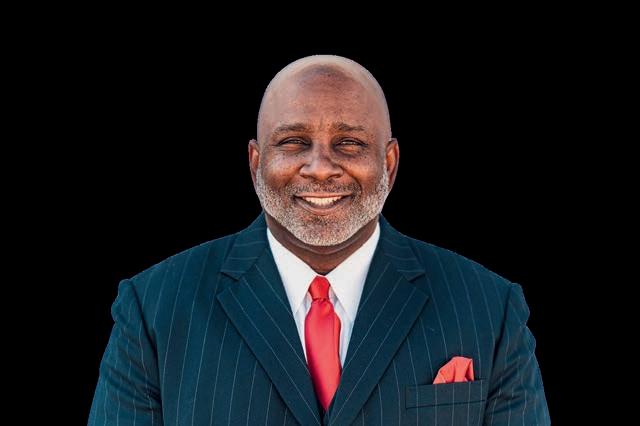

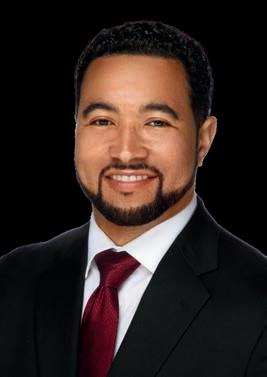
Michael Aaron Business Manager Chief Executive Officer, Local 1191
Charles Bailey President General Manager Lake Star Construction Services
Neil A. Barclay President CEO
The Wright Museum of African American History
Jody A. Connally Vice President of Human Resources, Detroit Wayne Integrated Health Network
Dwan Dandridge CEO Founder Black Leaders Detoit
Ma adou Diallo CEO Piston Grou
Andre Ebron Chief of Staff City Year
Lazar Favors CEO Detroit Black Film Festival and Black S irits Legacy
De ond Fernandez Anchor/Re orter
WDIV Local 4 Detroit
Cedric Flowers, VP of Gas O erations
DTE Gas

Ricky Fountain, Executive Director Community Education Commission
Darryl Gardner, Ph.D., Vice Provost of Student Success, Su ort Engagement Wayne State University
Rev. Ralph L. Godbee, Jr., Chief of Staff Trium h Church
Col. Ja es F. Grady, II Director Michigan State Police
Saul Green Former US Attorney, Eastern District of Michigan/Owner CEO, Michigan Bar er School
Antonio Green Director
James H. Cole Funeral Home
Michael Everett Hall, Es Attorney/Engineer Ford Motor Com any
Ja es Harris Chief City of Detroit Fire De artment
Derrick Headd, Sr VP, Pu lic Policy O erations Detroit Economic Growth Cor oration
Gregory Hines, Co-Founder Co-Owner
Amada Senior Care
Michael Jackson, II, Es Sr. VP of Planning Construction, Economic Develo ment Environmental Srvs, Wayne County Air ort Authority
Labrit Jackson, PEM Chief of Police
DPSCD De artment of Pu lic Safety
Jerlando F.L. Jackson, PhD Dean of Education and MSU Research Foundation Professor, Michigan State
Rod Liggons Director, Government Relations Detroit Regional Cham er
Derrick Jones Lopez, Ph.D., JD Assistant
Su erintendent for High School Trans ortation, DPSCD
Jay Love, Vice President, Facilities MGM Grand Detroit
Razzaa McConner, Chief Purchasing Officer
Adient
Jason McGuire, CEO Riverside Marina
Ray Moulden, CEO Moulden Allstate Agency
Tanathan Nelson Restaurant O erations
Director/Consultant, TLN Consulting
Phares A. Noel, II President CEO Diversified Engineering Conce ts
Hon. Byron Nolen Mayor City of Inkster, Michigan
Gerald Parker President CEO Ex uise Fire Safety

Wayne E. Phillips Financial Advisor/Owner Ameri rise Financial
Dr. Michael Pieh Physician
Sierra Medical Clinic
Dr. Norris Polk Physician
PEDS Urgent Care
Rodney Prater CEO Prater Commercial
Clarence Rose Senior Sales Executive Arrow Strategies
Ray ond A. Scott, MPH De uty Director, Buildings, Safety Engineering and Environmental, City of Detroit
Andre S ith Photo ournalist/Professor Wayne County Community College District
Diallo Robert S ith President CEO Life Remodeled
David L. Stone President Co-Founder Trion Solutions
Everett Stone, CFO and Senior Vice President Vanguard CDC
Lorenzo Suter, President CEO McLaren Oakland
Khali Sweeny, Founder CEO Detroit Boxing Gym
Edwin Tate , P.E., Senior Vice President WSP Engineering
Calvin Toone Vice President of Business Develo ment, MCL Jasco
Alphonso Wallace CEO Vestco Management Com any
Boyd White, III Mem er/Partner Dykema



An education is about more than earning a degree — it’s about building a life. At Wayne State University, students from all backgrounds have access to a top-tier education. Here, we combine in-class learning and Detroit-powered research, internships and community service opportunities. Our students graduate Warrior Strong, ready to innovate, lead and make an impact in countless in-demand fields.

Apply now for free using the application fee waiver code WSU2025 at wayne.edu/apply.
Fall 2025 transfer and first-time students: Apply by June 1 to be eligible for maximum consideration for merit scholarships and tuition pledge programs.



Ed Siaje President,


All across Michigan, the MEDC collaborated with statewide partners to develop a network of programs and services to empower people and places to thrive. Last year, we helped businesses pledge almost 18,000 jobs and earn more than $2 billion in revenue. We’re turning bold ideas into reality and making a lasting impact on lives.